











































sangeeta@firstviewgroup.com | +91 9372788472
kritika@firstviewgroup com| +91 9560787917
kawaldeep@firstviewgroup com | +91-8850563096

















































sangeeta@firstviewgroup.com | +91 9372788472
kritika@firstviewgroup com| +91 9560787917
kawaldeep@firstviewgroup com | +91-8850563096




Since 2003, VNT has consistently introduced new technologies and innovations, maintaining high standards in the evolving energy sector
VNT leads in five key domains, significantly impacting the Indian and Middle Eastern markets, with notable contributions in solar power and telecom connectivity.
VNT's growth is driven by a focus on team, innovation, and persistence, expanding globally while integrating Indian heritage and delivering superior products.
How does VNT ensure the highest standards of professionalism and quality in its products and services, particularly given the rapidly evolving energy sector?
Indeed, this holds true as India emerges beyond the 5th largest economy globally. India is witnessing significant growth in infrastructure,energy, and telecommunications and is striving towards a sustainable future for the nation Since our establishment in 2003, VNT has continuously adapted to new technologies and introduced disruptive innovations in quality procedures and inhouse testing facilities
Operating across five domains – telecom, solar, electric vehicles (EV), fire & safety, and industrial sectors – we have consistently led the market in each line of business
Our commitment towards harnessing innovative technologies in our offerings and adopting smart processes in our systems drives us to deliver cutting-edge solutions with high quality repeatedly with increasing scale With an unwavering focus on safety and quality control, we aim to provide unparalleled solutions that address the evolving needs of the critical sectors we serve
Ra Sh CEO Vrin Tech
What performance indicators can you share that reflect VNT's growth and impact on the Indian and Middle East markets?
As highlighted, VNT operates across five sectors – and holds market leadership in each domain Notably, our impact on the Indian and Middle Eastern markets is substantial In the solar sector alone, we have supplied solutions totaling over 40 GW in India and abroad Additionally, our wireless string monitoring solutions have assisted over 250 developers and EPC contractors in the solar industry In the telecommunications space, VNT's super high- efficiency SMPS plays a crucial pioneering role in connecting India, powering telecom towers nationwide, including in remote areas in most green way. This has significantly improved connectivity for end-users, enhancing their overall quality of life Moreover, our installation and service networks are experiencing rapid expansion, indicative of our continuous growth trajectory

How do VNT's super high-efficiency SMPS systems contribute to saving costs for telecom businesses, and what sets them apart in the market?
VNT's high-efficiency SMPS systems, now boasting a remarkable 98% efficiency rate, play a crucial role in reducing power loss and enhancing overall system efficiency by consuming less energy With approximately 1 million towers in India and a plan for installing another 1 5 million, consuming 3700 MWp of the nation's total power demand, even a 1% reduction in power demand can have a significant impact on India's overall power consumption We are pleased to note that all telecom operators are actively working to reduce power consumption by adopting highefficiency power products and solarizing telecom sites.
VNT takes pride in its leadership in both these initiatives, having supplied these solutions to thousands of sites and experiencing rapid growth in this sector.
What are your plans for overseas expansion? Currently, you are operating in all markets; what’s the future plan?
Aligned with our vision of "simplifying and providing innovative and efficient energy systems" and our mission to "help the world become greener, connected, and protected," we have already initiated operations in the Philippines, UAE, Indonesia, and Saudi Arabia Looking ahead, we aim to further expand our footprint into the African and Western markets Our unwavering commitment remains focused on delivering superior products and integrating the Indian heritage with a global outlook

Today VNT is the fastest growing telecom and solar power system supplier. Could you explain the strategies that have driven your expansion and success?
Team, Innovation, Persistence and Clear common goal to Evolve bigger and better every day!
Vrinda Nano Technologies has reached significant milestones, providing power management solutions to over 100,000 telecom sites, delivering combiner boxes and monitoring devices for more than 40 gigawatts of solar power plants worldwide, and successfully entering the EV charger market across various sectors We have protected over 250,000 telecom stations from climatic impacts such as lightning and diversified into consumer, industrial, railway, and defense sectors Additionally, we've developed ultrahigh-efficiency rectifiers and SMPS for telecom applications
Since 2003, our commitment to delivering reliable solutions and exceptional service has
VNT's commitment to innovation and quality resonates across sectors, driving us to deliver solutions that not only meet but exceed industry standards, propelling India towards a sustainable future.
driven our success Our field experience and technological adaptation ensure advanced solutions. We efficiently manage large-scale deliveries, offering comprehensive products, on-site solutions, and safety expertise, always prioritizing customer needs and maximizing uptime
With decades of expertise, we use an integrated approach to excel in power management, energy conservation, fire safety, lightning protection, and asset monitoring In sectors like telecommunications, renewable energy, defense, and railways, we innovate to ensure reliable, flexible, safe, and sustainable operations We focus on current client needs and future planning to enhance business utility
Our team of experts provides maintenance services to manage unforeseen risks We prioritize comprehensive audits, including earthing, electrical safety, and energy audits, offering services from visual inspections to detailed risk consulting. Our long-term vision underscores the resilience and reliability of our services



From AIFL For Captive Solar PV Project In
Avaada Energy, a subsidiary of the Avaada Group and a prominent player in the renewable energy sector, has obtained ₹315 crore in financing from Aseem Infrastructure Finance Ltd (AIFL) for a solar photovoltaic (PV) power project in Karnataka. This project is part of a long-term captive Power Purchase Agreement (PPA) with the Karnataka Cooperative Milk Producers’ Federation Ltd (KMF) The solar project, situated in the Kalaburagi district, will supply power to KMF, the leading organization in the dairy cooperative movement in Karnataka KMF holds an A+ (Stable) rating from ICRA, indicating its strong financial stability.
ADB Pledges $2.6 Billion To India For Urban Development And Power Sector Reforms In 2023
In 2023, the Asian Development Bank (ADB) pledged $2 6 billion in sovereign lending to India, targeting projects aimed at urban development, industrial corridor enhancement, power sector reforms, climate resilience, horticulture support, and connectivity improvement Additionally, ADB provided $23 53 million in technical assistance and $4 1 million in grants The bank also committed over $1 billion for private sector projects within the year
ReNew Partners with Societe Generale For USD 1 Billion In Financing And Advisory Solutions For Renewable Energy Projects
India’s ReNew signed an MoU with Societe Generale to support the financing and development of energy transition projects The agreement includes up to USD 1 billion in debt financing and advisory solutions over three years, focusing on solar, wind, green hydrogen, and more. This partnership aims to accelerate ReNew’s renewable energy initiatives and contribute to India’s net zero goals.
ReNew Partners with Societe Generale for USD 1 Billion in Financing and Advisory Solutions for Renewable Energy Projects
ReNew announced the signing of a Memorandum of Understanding (MoU) with Societe Generale. The agreement aims to bolster the financing and development of ReNew’s strategic energy transition projects in India and globally. The MoU outlines up to USD 1 billion of support over the next three years, encompassing debt financing and advisory solutions This collaboration will focus on utility-scale energy projects, including solar, wind, complex renewables, green hydrogen, energy storage, and solar module manufacturing
ADB Sanctions $148.5 Million for Modernising Sikkim’s Power Distribution
The Asian Development Bank (ADB) has sanctioned a $148 5 million loan aimed at modernizing and bolstering the reliability, quality, and resilience of the electricity supply in Sikkim This initiative aligns with Sikkim’s Power for All program, ensuring continuous, high-quality electricity access for households, industries, businesses, and the public, according to an ADB statement.
KPI Green Energy Limited Board Approves Fundraising Of Up To ₹1,000 Crores
KPI Green Energy Limited’s Board of Directors approved raising ₹1,000 Crores through a Qualified Institutions Placement (QIP) The fundraising involves issuing equity shares or equity-linked securities convertible into shares, subject to regulatory approvals and a special resolution from shareholders. This initiative aims to support growth objectives and enhance the company’s capital structure, demonstrating a strategic commitment to expanding renewable energy operations Shareholders will be informed about the approval date for this significant fundraising endeavor
GP Eco Solar Aims for Dominance in Clean Energy Sector; Plans ₹30-35 Crore IPO on NSE Emerge
GP Eco Solutions India Limited (GPES) has announced plans to raise ₹30-35 crore through an initial public offering (IPO) on NSE Emerge This strategic initiative highlights GPES’s dedication to accelerating its growth in the rapidly expanding solar power industry. “GP Eco Solar intends to raise capital between ₹30 Crore and ₹35 Crore, subject to approval The IPO funds will fuel our growth, with ₹12 45 Crore allocated for working capital and expansion, and ₹7 6 Crore will be invested in our subsidiary Invergy India for a new solar inverter assembly facility in Noida Remaining funds will go towards general corporate purposes,” said, Deepak Pandey, Promoter & Managing Director, GPES
ReNew Partners with Societe Generale for USD 1 Billion in Financing and Advisory Solutions for Renewable Energy Projects
ReNew announced the signing of a Memorandum of Understanding (MoU) with Societe Generale. The agreement aims to bolster the financing and development of ReNew’s strategic energy transition projects in India and globally The MoU outlines up to USD 1 billion of support over the next three years, encompassing debt financing and advisory solutions This collaboration will focus on utility-scale energy projects, including solar, wind, complex renewables, green hydrogen, energy storage, and solar module manufacturing
Enfinity Global Secures $135 Million From CPP Investments For 1.2 GW Solar And Wind Projects In India
Enfinity Global Inc has announced the signing of a $135 million financing agreement for the development and construction of 1 2 GW of solar and wind projects in India The financing is provided by the Canada Pension Plan Investment Board (CPP Investments) through subsidiaries of CPPIB Credit Investments Inc. The projects, located in Maharashtra, Delhi, Karnataka, Rajasthan, and Uttar Pradesh, are in advanced stages of development and are expected to be commissioned between 2025 and 2026 Upon completion, these projects will generate an estimated 2 4 GWh of clean electricity annually, sufficient to power over two million Indian homes and offset 2 6 million tons of CO2 emissions

AMPIN Energy Transition Secures $35 Million Investment From responsAbility For Renewable Projects In India
Avaada Energy Secures ₹1,190 Crore Financing For 400 MW Solar Project In Gujarat
Avaada Energy, the renewable energy arm of the Avaada Group, has announced the securing of a green financing deal worth approximately ₹1,190 crore (around USD 143 million) from the State Bank of India (SBI), India’s largest public sector lender This financing will facilitate the development of a 400 MWp solar photovoltaic power project in Gujarat’s Surendra Nagar district.
AMPIN Energy Transition has secured a significant investment from responsAbility, a Swiss-based impact asset manager. The investment is part of responsAbility’s comprehensive USD 500 million climate investment strategy aimed at reducing CO2 emissions in Asia responsAbility plans to invest up to USD 35 million in AMPIN to enhance its renewable energy initiatives across India The funds from this investment will support a range of projects under AMPIN’s Special Purpose Vehicles (SPVs), particularly in the commercial and industrial solar sectors.
Secures $1.44
AdaniConneX, a joint venture between Adani Enterprises and EdgeConneX, has secured India’s largest sustainability-linked financing, reaching up to $1 44 billion, with an initial commitment of $875 million This substantial financial boost increases AdaniConneX’s total construction financing to $1.65 billion, following a previous $213 million facility obtained in June 2023. The newly acquired funds will be directed toward the development of data center facilities that incorporate cutting-edge technologies and renewable energy sources This initiative is part AdaniConneX’s broader strategy to enhance environme sustainability and operational efficiency in its data ce operations
BluPine Energy Secures Financial Closure For 120 MW Solar Project In Sadla, Gujarat
BluPine Energy, a prominent player in the renewable energy sector established in India by global infrastructure investor Actis, has announced the successful financial closure of its 120 MW Solar Project located in Sadla, Gujarat under GUVNL 18 The company has achieved a significant milestone by securing debt financing for the project from HDFC Bank, India’s largest private sector bank. The total debt sanctioned for this ambitious venture amounts to ₹418 crores (USD 50 1 Million) Upon completion, the solar plant is projected to generate approximately 3 23 lakh MWh of solar energy annually, offsetting an estimated over 2 96 lakh tons of CO2 eq annually and providing power to approximately 2 7 lakh households annually
Sri Lanka Partners With Adani Green Energy For $442 Million Renewable Power Project



Sri Lanka has entered into a 20-year agreement with Adani Gre Energy Ltd, a subsidiary of the Adani Group led by billiona Gautam Adani, to build two wind power facilities in the country s Northern province. The deal, aimed at bolstering the nation’s renewable energy capabilities, involves the construction of wind power stations in Mannar town and Pooneryn village, with a total expected capacity of 484 megawatts The project, approved last February, represents a significant investment of $442 million by Adani Green


Worth JPY 60.536 Billion For Sustainable Development Projects In India
REC Limited has secured a noteworthy Green Loan totaling Japanese Yen (JPY) 60 536 billion This financial backing is aimed at financing eligible green projects in India, marking a pivotal step towards sustainable development within the country The Green Loan, supported by an 80% guarantee from the Italian Export Credit Agency, SACE, under their innovative Push Strategy program, represents a pioneering collaboration between an Indian government entity and SACE.


Gujarat Toolroom Ltd. Invests ₹5.72 to 6.5 Billion in 65-Acre Wind Solar Hybrid Power Plant in Gujarat
Gujarat Toolroom Limited (GTL), has announced a major expansion in its renewable energy initiatives The company has secured a 65acre plot of land in Gujarat on a long-term lease to establish a stateof-the-art clean energy hybrid power plant This new development is strategically located, with 60 acres designated for solar panels expected to generate 1 MW of energy per hour per acre The remaining 5 acres will house critical power management infrastructure such as transformer stations and high-voltage line terminals
CESC Ltd Expands Renewable Portfolio With Acquisition Of 300-MW Solar Park Developer In Rajasthan
CESC Ltd, through its subsidiary Purvah Green Power, has successfully acquired Bhadla Three SKP Green Ventures, enhancing its foothold in the renewable energy sector. The acquisition, valued at ₹3 84 crore, gives Purvah Green Power full ownership of the company tasked with developing a 300-MW solar park in Phalodi district, Rajasthan
Tender >
SECI’s ISTS-XV Scheme For 1,200 MW Solar PV Power Projects With Energy Storage Systems In India
SECI’s Global Tender For Electrolyser Manufacturers: Accelerating Green Hydrogen Production In
BPCL Invites Bids for 71 MW Solar Power Project In Prayagraj, Uttar Pradesh
NHPC Initiates Tender for 1 2 GW Solar Power Projects In India
SECI’s 1000 MW Solar Project Advances With Competitive Tariff Adoption
BHEL Issues Tender For 300 MW Floating Solar Project In Odisha For NHPC
SECI Invites Bids For 1,200 MW ISTS-Connected Solar PV Projects Under SECI-ISTS-XVI (2024)
Singareni Collieries Invites Tenders For 1 MW/2 5 MWh Battery Energy Storage System at 28 MW Mandamarri Solar Plant
Tata Institute of Fundamental Research Issues Tender for 500 KWp Rooftop Solar PV Plant
SECI Invites Bids for 7.5 MW Solar PV Power Plant In Rajasthan
RECPDCL Opens Bidding for 200 MW Solar PV Project In Jhansi, Uttar Pradesh
CIL Navikarniya Urja Limited Invites Bids for 20 MW AC Solar Project In Orissa
KELTRON Invites E-Tenders for 2-Year Maintenance Of 1 MWp Solar Plant
Travancore Cochin Chemicals Ltd Invites Bids For 22 MW Renewable Energy Power Plant Under Group Captive SPV Model
NHPC Invites Competitive Bids For 200 MW Solar Power Project In Gujarat
Military Engineer Services Issues Tender For Rooftop Solar Power Plant At ICGS Mundra
CIL Navikarniya Urja Limited Invites Bids For 20 MW AC Solar Project In Orissa
Military Engineer Services Issues Tender For Rooftop Solar Power Plant At ICGS Mundra
NTPC Renewable Energy Invites Bids For 225 MW Solar PV Project In Gujarat’s Khavda
Singareni Collieries Releases Consultancy Tender For 67.5 MW Solar Project
Coal India Subsidiary Invites Bids For 20 MW Solar Project In Odisha
SJVN Green Energy Invites Bids For 376.60 MWp Solar Module Procurement For GUVNL Project
MSEDCL Seeks Bids For 1,600 MW Coal-Based Power And 5000 MW Solar Projects
West Central Railway Invites Bids For 2 33 MW Rooftop Solar Projects In Kota Division
RECPDCL Seeks Expressions Of Interest for Acquisition Of 200 MW Operational Renewable Energy Assets
SAIL’s Bhilai Steel Plant Partners With CREDA For 3 MW Rooftop Solar Power Initiative
Indian Railway Releases Tender For Supplying 2.017 MW Rooftop Solar PV System
GAIL (India) Limited Launches Tender For Rooftop Solar PV Plant Project
RECPDCL Seeks Expressions Of Interest For Acquisition of 200 MW Operational Renewable Energy Assets
Railway Issues Tender For Rooftop Solar Installations Across Vijayawada Division Buildings
KELTRON Announces Bidding For Two-Year Maintenance Contract Of 1 MW Solar Project In Ramakkalmedu /
East Central Railway Seeks Bids For 1 1 MW Rooftop Solar Installation At Sonpur Division
The Military Engineer Services Issues Tender For Maintenance Of 5 MW Solar Project In Madhya Pradesh
Indian Railways Invites Bids For 1 1 MW Solar PV Projects In Bihar
HPCL Renewables Seeks EPC Services For 78 MW WindSolar Hybrid Project To Support Mumbai Refinery
Avaada Energy has achieved a significant milestone by winning the single largest bid of 1,050 MWp capacity of a solar project in a recent tender issued by the Renewable Energy Implementing Agency (REIA) NTPC This achievement underscores Avaada’s expertise and dedication to contributing to India’s RE targets. The company has secured the 1,050 MWp capacity solar project at a competitive tariff of ₹2 69 per kWh

Onix Renewable Limited Secures 187 MW Solar Projects In Gujarat Under PM-KUSUM
Onix Renewable Limited has announced that its subsidiary, Onix Trans Stellar, has been awarded 187 MW of solar projects under the Pradhan Mantri Kisan Urja Suraksha Evam Uthan Mahabhiyaan (PMKUSUM) scheme These projects will be distributed across 60 different locations in Gujarat
Orb Energy’s New 35 MW Solar Park Set to Boost SME Power Needs in Karnataka
Orb Energy, has inaugurated its first 35 MW (DC) ground-mounted solar park in Arsikere, Hassan district The 110-acre park is designed to produce 5 24 crore units of green power annually, reducing carbon dioxide emissions by 45,000 tons each year This initiative specifically aims to empower SMEs in the region.
Vikram Solar Secures Major 397.7 MWp Module Supply Contract For NTPC’s Khavda Solar Project
Vikram Solar has obtained a significant 397 7 MWp module supply order from NTPC Renewable Energy Limited The supplied modules will be instrumental in powering the extensive 1,255 MW Khavda Solar Project in Gujarat. These advanced bifacial DCR modules, with a minimum capacity of 540 Wp, adhere to the stringent ALMM standards.
DGVCL’s 212.0 MW Solar Power Initiative To Empower Gujarat’s Agricultural Feeders
The Dakshin Gujarat Vij Company Limited (DGVCL) has embarked on a transformative project to solarize various 11 KV feeders across its distribution network This initiative, aligned with the Pradhan Mantri Kisan Urja Suraksha evem Utthan Mahabhiyan (PM KUSUM) scheme, aims to leverage solar power to energize agricultural operations, marking a significant shift towards green energy. The project involves setting up 112 solar power plants with a combined capacity of 212 0 MW
Juniper Green Energy takes a leap in clean energy generation with the commissioning of the Jalkot Solar Project in Maharashtra The project, boasting an impressive 75 MW of solar energy, adds a significant feather to the cap of India’s renewable energy capabilities. This ambitious endeavor is a long-term PPA of 25 years with MSEDCL With an agreed tariff of ₹2 90, the Jalkot Solar Project stands as a model of economic and environmental sustainability
Sineng Electric Leads The Charge By Powering A 641MW Solar Project In Gujarat
Sineng Electric announced its instrumental role in powering a 641 MW solar project in Gujarat, India, part of the 30 GW Khavda Solar Park Once completed, the Khavda Solar Park will power 16 1 million Indian homes and stand as the world’s largest renewable energy installation
Chhattisgarh Debuts 15 MW Floating Solar Plant
Led By SAIL To Propel Sustainable Energy Goals
SAIL’s Bhilai Steel Plant is pioneering a 15 MW floating solar power project at Chhattisgarh’s Maroda-1 reservoir to boost sustainability and reduce carbon emissions This initiative will generate around 34 26 million units of green power annually, exclusively for BSP’s use, potentially cutting CO2 emissions by 28,330 tonnes per year.

Amplus has announced the successful launch of Project Lakshmi, a 73.4 MWp intra-state open-access solar plant located in Jhansi, Uttar Pradesh This marks the company’s third such installation in the state, following the successful implementations of Project Mirza and Project Deoria
ReNew Power Secures 5 New PPAs, Adding 2.2 GW To Bolster Renewable Energy Portfolio
ReNew has significantly bolstered its renewable capacity with the signing of five new Power Purchase Agreements (PPAs), collectively adding approximately 2 2 GW to its portfolio This expansion brings ReNew’s total contracted capacity to 15 6 GW, reinforcing its role in India’s push towards green energy
Tata Power Renewable Energy Limited Inks PPA With SJVN Limited For 460 MW Firm And Dispatchable Renewable Energy Project
Tata Power Renewable Energy Limited (TPREL) has inked a PPA with SJVN Limited (SJVN) for a 460 MW Firm and Dispatchable Renewable Energy (FDRE) Project The facility, tailored to fulfill the 460 MW FDRE mandate, incorporates solar, wind, and battery storage technologies to optimize energy dispatch during peak periods, enhancing grid stability
Vikram Solar Lands 250 MW Module Supply Order for Gujarat’s Renewable Energy Park
Vikram Solar, a key player in India’s solar module manufacturing industry, has announced securing a significant 250 MW order from Gujarat Industries Power Company Limited (GIPCL) The company has received the Letter of Intent (LoI), marking a crucial step forward in bolstering India’s solar energy capacity and contributing to the country’s solar goals
Gujarat’s Renewable Energy Push: GUVNL Secures 600 MW Of Solar Power Through SECI Agreement
Juniper Green Energy Inks PPA To Set Up 1 GW RE Capacity

Juniper Green Energy is excited to announce a landmark Power Purchase Agreement (PPA) with SJVN, securing a 320 MW firm and dispatchable renewable energy contract This agreement sets the stage for the development of approximately 1 GW of capacity across two states Gujarat and Rajasthan
Delhi’s BYPL Partners With SECI For 100 MW WindSolar Hybrid Power Project
BSES Yamuna Power Limited (BYPL), a prominent power distributor in Delhi, has recently agreed to acquire 100 MW of wind-solar hybrid power. This initiative is part of a broader strategy to enhance the use of renewable energy sources across the region
GUVNL is advancing Gujarat’s solar power capacity by seeking approval from the Gujarat Electricity Regulatory Commission for a Power Sale Agreement (PSA) with SECI to procure 600 MW of solar power at ₹2 60 per kWh This supports GUVNL’s renewable purchase obligations and addresses rising power demand, especially during crucial solar hours for agriculture
Waaree Energies Wins 400 MW Solar Module Supply Contract From GIPCL
Waaree Energies Limited won a substantial 400 MW module supply order from Gujarat Industries Power Company Limited (GIPCL) This contract is pivotal for Waaree as it involves the delivery of advanced bifacial solar PV modules for the sprawling 2,375 MW Renewable Energy Park located near Village Khavda in the Great Rann of Kutch, Gujarat

MNRE issues a memorandum granting exemption from ALMM requirements for renewable energy plants in SEZs or EOUs supplying power exclusively to Green Hydrogen production facilities Effective until December 31, 2030, this move aims to promote Green Hydrogen utilization, aligning with strategic directives from the Minister of Power and New & Renewable Energy
Solar PV Grid Interactive
The Gujarat Electricity Regulatory Commission (GERC) has proposed the fourth amendment to streamline net metering regulations for rooftop solar PV systems in Gujarat. Key provisions include updating transformer capacity annually, shifting infrastructure costs to distribution licensees, and detailing installation procedures Charges for system strengthening vary based on consumer type and capacity The amendment emphasizes a structured timeline for project implementation, including technical feasibility reports and connectivity consent. GERC aims to optimize processes, facilitating Gujarat’s transition to renewable energy with enhanced efficiency.

BERC Proposes New Amendments To Boost Rooftop Solar Adoption In Bihar (2024)

BERC initiates a proceeding to amend rooftop solar grid-interactive system regulations, inviting public comments and holding a hearing The amendment aims to expedite connectivity by mandating distribution licensees to issue guidelines within three months. Applications for systems up to 10 kW will be automatically accepted without feasibility studies, streamlining the process. These changes align with BERC’s goal of promoting renewable energy adoption in Bihar, fostering a more efficient and sustainable energy distribution system
MERC Proposes 2024 Draft Second Amendment Regulation For Grid Interactive Rooftop Renewable Energy Systems
Maharashtra's draft amendment to Grid Interactive Rooftop Renewable Energy Systems guidelines enhances accessibility by allowing both individual and collective renewable energy setups. It introduces virtual net metering, enabling shared renewable energy production among multiple consumers, such as housing societies The amendment simplifies processes for installations up to 10 kW, streamlines approvals, and clarifies energy accounting methods These changes, aligned with the Electricity Act, 2003, aim to boost rooftop solar capacity to 5,000 MW, reflecting the state's commitment to sustainable energy
MNRE Clarifies ALMM Order For Solar PV Modules: Applicability Starting 10th April 2024
The MNRE has clarified that the Approved List of Models and Manufacturers (ALMM) Order for solar PV modules applies only to projects with bid submission deadlines on or after April 10, 2021 This memorandum aims to eliminate confusion, ensuring that projects submitted before this date are exempt from the ALMM Order for List I (Modules) This clarification, approved by the competent authority within MNRE, is crucial for project developers and bidders to ensure proper regulatory compliance and streamline solar PV project implementation in India
Himachal Pradesh Streamlines Draft Regulations For Rooftop Solar PV Systems With Third Amendments
The Himachal Pradesh Electricity Regulatory Commission has introduced the Third Amendment Regulations of 2024 to streamline rooftop solar PV systems’ regulatory process Effective upon publication, these amendments designate HIMURJA and the State Electricity Board as the implementing agencies Key changes include simplified registration, shorter timelines for approvals, and technical feasibility study exemptions for systems up to 10 kW. Aimed at reducing delays and enhancing efficiency, these amendments promote solar energy adoption and offer financial assistance to consumers in Himachal Pradesh
Himachal Pradesh Streamlines Draft Regulations For Rooftop Solar PV Systems With Third Amendments
The Himachal Pradesh Electricity Regulatory Commission's Third Amendment Regulations of 2024 streamline rooftop solar PV system processes, emphasizing efficiency. New definitions include the State Nodal Agency, covering HIMURJA, and the Himachal Pradesh State Electricity Board Limited The amendments simplify registration, approvals, and subsidies, mandating adherence to specific timelines Systems up to 10 kW no longer need technical feasibility studies These changes aim to expedite solar adoption, reduce bureaucratic hurdles, and enhance solar energy implementation in Himachal Pradesh
MNRE Clarifies ALMM Order For Solar PV Modules: Applicability Starting 10th April 2024
The Ministry of New and Renewable Energy (MNRE) has clarified that the Approved List of Models and Manufacturers (ALMM) Order, 2019, applies to solar projects with bid submissions after April 10, 2021 Projects submitted before this date are exempt from ALMM List I (Modules) requirements. This clarification ensures stakeholders comply correctly, preventing misunderstandings and aiding smooth progress for solar PV projects across India, reaffirming regulatory adherence and flexibility for ongoing projects
Chhattisgarh State Electricity Regulatory Commission Sets Tariffs For Renewable Energy Projects For FY 2024-25
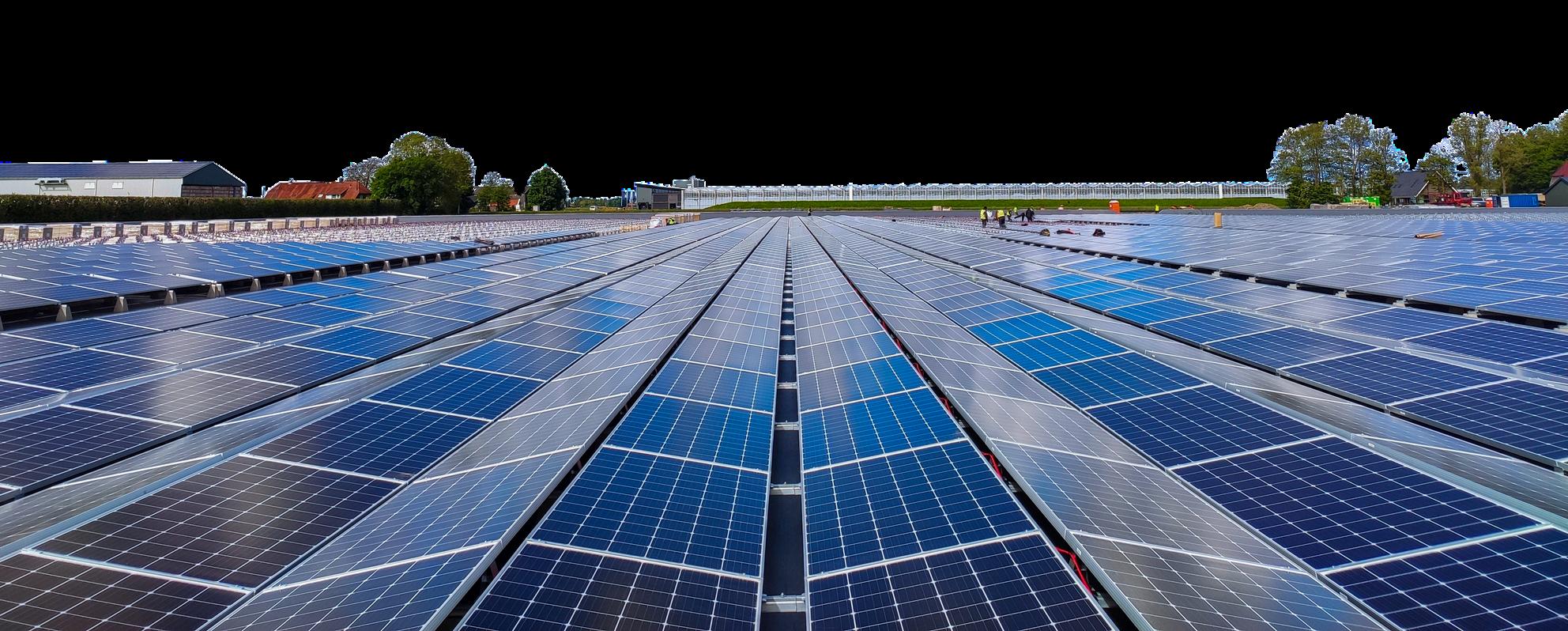
The Chhattisgarh State Electricity Regulatory Commission has issued a draft order to determine tariffs for various renewable energy technologies for FY 2024-25 Covering small hydro, non-fossil fuel cogeneration, solar PV (0 5-2 MW), and biogas projects, the order also sets energy charges for existing biomass plants and fixed charges for those that began operations in 2008-09 The commission’s standard tariff ensures financial clarity and sustainability for developers. Key provisions include capital cost norms, a 70:30 debt-to-equity ratio, a 16 78% return on equity, and specified operational costs This initiative promotes fair and predictable tariffs, fostering renewable energy growth in Chhattisgarh
Inter-State Open Access Breakthrough: Solar Company Granted Grid Connection Without Dedicated Feeder
The Chhattisgarh State Electricity Regulatory Commission has permitted Hind Multi Services Private Limited to connect its 3.15 MW solar project to the regional grid without a dedicated feeder, reducing costs and streamlining operations This decision allows the company to use existing infrastructure, injecting solar power into the state grid for its coal washery operations Supported by local power entities, the approval underscores regulatory flexibility and the evolving approach to energy management, promoting renewable energy expansion and operational efficiency
Pradesh Streamlines Draft Regulations For Rooftop Solar PV Systems With Third Amendments
The Himachal Pradesh Electricity Regulatory Commission has introduced the Third Amendment Regulations of 2024 to streamline rooftop solar PV systems’ regulatory process. Effective upon publication, these amendments designate HIMURJA and the State Electricity Board as the implementing agencies Key changes include simplified registration, shorter timelines for approvals, and technical feasibility study exemptions for systems up to 10 kW Aimed at reducing delays and enhancing efficiency, these amendments promote solar energy adoption and offer financial assistance to consumers in Himachal Pradesh.
Chhattisgarh Advances Renewable Energy Regulations With New Banking And Settlement Proposals
The Chhattisgarh State Electricity Regulatory Commission has proposed refined modalities for independent distributed renewable energy systems (IDRES) exceeding 500 MW or operating before December 27, 2023. These revisions aim to streamline energy banking, accounting, settlement, and wheeling processes. Banked energy can be carried forward within the same month or to the subsequent month in the same cycle, with surplus forfeited if exceeding 30% of monthly consumption Stakeholder feedback is sought before finalizing the proposals

India’s Renewable Energy Ministry Streamlines
The Ministry of New & Renewable Energy has revised the policy for Solar Park development Central Public Sector Undertakings and their Joint Ventures can now submit DPRs directly to SECI, IREDA, and MNRE without State Government Committee approval State PSUs need departmental approval. Private developers still require State Government Committee approval. The change aims to accelerate solar park development.
MNRE Clarifies Domestic Content Requirements For Solar PV Projects, Endorses Local Manufacturing
The MNRE clarified that the ALMM Order for List I (Modules) applies only to solar projects with bid submissions after April 10, 2021 Projects with earlier submissions are exempt from these requirements. This clarification aims to ensure compliance and avoid confusion among stakeholders, emphasizing the importance of adhering to current regulatory standards in solar PV projects
Andhra Pradesh Electricity Regulatory Commission Introduces Green Energy Open Access, Charges, And Banking Regulation, 2024
APERC introduces the "Green Energy Open Access, Charges, and Banking Regulation, 2024," facilitating easier access to green energy and revising associated charges to incentivize renewable energy adoption The regulation also establishes new banking rules to manage energy from renewable sources efficiently This initiative aims to boost the local green energy market, attract investments, and position Andhra Pradesh as a leader in renewable energy adoption. It is expected to spur economic growth and innovation in the region while contributing to environmental sustainability
GUVNL Seeks Tariff Adoption For 1,125 MW Solar Projects In Gujarat Amid Regulatory Scrutiny
APERC introduces the "Green Energy Open Access, Charges, and Banking Regulation, 2024," aiming to promote sustainable energy practices in Andhra Pradesh The regulation facilitates easier access to green energy, revises procurement charges, and introduces new banking rules to manage renewable energy efficiently By making green energy more accessible and economically viable, Andhra Pradesh aims to lead in renewable energy adoption, reduce carbon emissions, and foster economic growth and innovation in the region.
The Joint Electricity Regulatory Commission for Manipur and Mizoram introduces regulations to refine the financial framework for green energy adoption The focus is on adjusting charges related to accessing renewable power, including transmission and wheeling fees, banking energy rules, standby arrangement costs, and crosssubsidy surcharges. These measures aim to make renewable energy more appealing and feasible for consumers, supporting environmental sustainability and fostering a resilient energy infrastructure
Ministry Sets Ambitious 43.3% Renewable Energy Target for 2030, Emphasizes 41.13 GW Battery Storage and 18.6 GW Pumped Hydro
India’s Ministry of Power mandates states to increase renewable energy consumption from 24.3% in 2023 to 43.3% by 2030. The policy, highlighted in a NITI Aayog paper by Venugopal Mothkoor, Dr Anjali Jain, and Rajnath Ram, emphasizes Renewable Purchase Obligations (RPOs) for DISCOMs The report details storage needs using the TIMES-VEDA tool, projecting 18 6 GW of Pumped Hydro and 41 13 GW of 5-hour Battery Energy Storage Systems (BESS) by 2029-30. Regional requirements are outlined to ensure a sustainable energy transition.
Global Tender For Electrolyser Manufacturers: Accelerating Green Hydrogen Production In India
India has launched a Global Tender for Electrolyser Manufacturers (EM) under the Strategic Interventions for Green Hydrogen Transition (SIGHT) Scheme The tender promotes domestic electrolyzer manufacturing and Green Hydrogen production Bids, opening on June 28, 2024, fall into three buckets with capacities of 1,100 MW, 300 MW, and 100 MW EMs must meet energy consumption and performance criteria, with incentives available for five years Penalties for delays and non-compliance are outlined, and project locations are flexible. This initiative supports India’s renewable energy goals and combats climate change.
MNRE Exempts Renewable Energy Plants in SEZs and EOUs from RLMM Requirements for Green Hydrogen Production
The Ministry of New & Renewable Energy (MNRE) has exempted renewable energy plants in Special Economic Zones (SEZs) and Export Oriented Units (EOUs) supplying power exclusively for Green Hydrogen production from the Approved List of Models & Manufacturers (ALMM) requirements for Solar PV Modules This exemption, effective for plants commissioned by December 31, 2030, applies regardless of whether the production facilities are within the same or different SEZs/EOUs This move supports India's Green Hydrogen production and aligns with the Minister's approvals

Capacity By 18.5 GW In FY 2024, With Solar Contributing 15 GW
India has significantly advanced its renewable energy capabilities, as reported in the latest CEEW Centre for Energy Finance (CEEW-CEF) Market Handbook In the financial year 2023-2024, renewable sources contributed a remarkable 71% to the approximately 26 gigawatts (GW) of new power generation capacity added in the country This increase brings India’s total installed energy capacity to 442 GW, with renewables now making up about 144 GW or 33%, and hydroelectric power contributing roughly 47 GW or 11%. For the first time, the share of coal and lignite has dropped below 50%
GAIL (India) Ltd has inaugurated its first green hydrogen plant in Vijaipur, Madhya Pradesh, featuring a 10 MW proton exchange membrane electrolyzer imported from Canada The plant will produce 4 3 tonnes of 99 999% pure green hydrogen daily using solar power This aligns with India's National Green Hydrogen Mission, aiming for 5 million tonnes annually by 2030. Initially, the hydrogen will fuel Vijaipur's processes, with plans for distribution. GAIL is also developing 20 MW of solar capacity to support the plant.
AIS and INOXAP Initiate Solar-Driven Green Hydrogen Production For Float Glass In India
Asahi India Glass Limited (AIS) and INOX Air Products (INOXAP) have launched India's first green hydrogen plant for the float glass industry in Soniyana, Chittorgarh, Rajasthan Utilizing solar energy, the plant will produce 190 tons of green hydrogen annually, starting with 95 tons in the first phase by July 2024 INOXAP will manage the plant's operations for 20 years, while AIS funds the solar infrastructure This initiative aligns with India's National Green Hydrogen Mission, aiming for significant CO2 emission reductions and sustainable energy solutions
Tata Steel SEZ and Hygenco Ink MoU for Green Hydrogen And Ammonia Project In Odisha
Tata Steel Special Economic Zone Limited (TSSEZL) and Hygenco have signed an MoU to establish a green hydrogen and ammonia project at TSSEZL’s Gopalpur Industrial Park in Odisha Hygenco plans to produce 1 million tonnes annually, with the first phase operational by December 2026. TSSEZL's Manikanta Naik highlighted the park's total production capacity now at 2 6 million tonnes per annum Amit Bansal of Hygenco emphasized their global vision for cost-effective green ammonia production, leveraging Gopalpur’s strategic logistics and export facilities

Trina Solar's Elementa 2, a grid-scale lithium iron phosphate battery system, offers enhanced capacity and a 26% space reduction
Trina Solar predicts advancements in battery tech, AI, and hybrid systems, leveraging strong R&D and intelligent manufacturing.
Trina Solar tailors solutions for Asia Pacific with region-specific products, integrated solar and storage systems, and proactive regulatory compliance
What recent energy storage innovations has Trina Solar showcased in Asia Pacific? What sets these products apart in today's market?
Trina Storage (a business unit under Trina Solar) has introduced Elementa 2, a grid-scale lithium iron phosphate (LFP) battery system designed for utility-scale projects in Asia Pacific The Elementa 2 has undergone extensive upgrades in cell, pack, and system capacity These enhancements aim to achieve an optimal balance between capacity and cost, packed into a standardised 20ft container What sets it apart is that the Elementa 2 is built from the ground up using Trina’s vertically integrated LFP cells, manufactured in-house The Trina 306Ah LFP cells have a lifespan of up to 12,000 cycles It is further optimised for thermal management and battery management, as well as monitoring Another feature of the Elementa 2 is its spacesaving prowess, achieving a remarkable 26% reduction through a one-side door open feature and back-to-back system layout. Elementa 2 also offers more operational flexibility and is suitable for stand-alone, AC and DC-coupled systems
What technology trends do you predict will influence energy storage in Asia Pacific over the next five years, and how will Trinasolar capitalize on them?

Over the next five years, key technology trends will include advancements in battery technology, AI integration for energy management, and the growth of hybrid renewable systems The foundation of all these trends is technological innovation and quality products As such, Trinasolar remains committed to research and development and continues to set industry standards and benchmarks for performance and sustainability Trina Storage has established four R&D platforms: Energy Storage Battery Research Institute, Power Electronics Technology R&D Center, Energy Storage
How does Trinasolar drive innovation to create tailored solutions for Asia Pacific markets?
Trinasolar drives innovation through robust R&D and a deep understanding of regional market needs By actively engaging with local stakeholders, we tailor our solutions to meet specific regional requirements For example, offer two versions of the Elementa 2 in APAC –4MWh and 5MWh – to cater to varying preferences across different countries In addition, our integrated approach, combining solar modules, trackers, and storage systems, ensures comprehensive solutions for the Asia Pacific markets
Engineering Technology Center, and Digital Energy Research Institute[1] The company has been accredited by UL, TÜV SÜD, and CNAS as a witness laboratory Our investment in intelligent manufacturing and AI-driven management systems ensures we deliver efficient and reliable solutions Leveraging our vertically integrated capabilities and strong R&D platforms, we will continue to lead in providing advanced, comprehensive energy storage solutions. DID YOU KNOW? ?
Trina Storage goes above and beyond regulatory compliance, prioritizing safety and performance to exceed customer expectations in the dynamic landscape of energy storage.


Wha exist in Asia Pacific, and how does Trinasolar address them?
A significant aspect that cannot be overlooked is the diverse landscape among countries within the Asia Pacific region Each country presents unique regulatory requirements, grid integration challenges, and varying levels of market maturity regarding energy storage deployment
Trinasolar invests considerable effort in understanding the electricity markets and regulations regarding renewable energy generation By leveraging our expertise and experience, we aim to develop solutions that can help companies attain their net-zero and sustainability goals
Moreover, our unique position as a total solutions provider, offering modules and trackers and energy storage systems, sets us apart in the industry Our significant in-house battery cell manufacturing capacity supports our energy storage involvement, offering
into these vertical industries broadens our reach and allows us to diversify beyond traditional solar offerings This is particularly crucial in pivotal markets like India, Japan and Australia, where there is a growing interest in green hydrogen, ammonia, and round-theclock (RTC) power solutions Our ability to innovate and adapt ensures that we remain at the forefront of the renewable energy sector, meeting the evolving needs of the Asia Pacific markets.
In addition, by having Trinasolar as a single procurement source for solar modules, trackers, and BESS helps to streamline processes, allowing for faster delivery, smoother negotiations, and unified after-sales service This approach not only reduces costs but also ensures efficiency, especially in challenging site conditions
This positions us not just as a product supplier but as an indispensable partner for most EPCs and developers
with evolving regulations and meet customer expectations in Asia Pacific?
Trinasolar proactively monitors regulatory changes and participates in industry forums to ensure compliance and exceed customer expectations. Our solutions, like the Elementa 2, feature robust fire mitigation, precise thermal management, and intelligent operation and maintenance, ensuring safety and performance We exceed regulatory requirements and prioritize customer service with comprehensive support and training programs, helping customers maximize the benefits of our energy storage solutions
Trinasolar’s commitment to innovation and quality positions us as a leader in shaping the future of energy storage in Asia Pacific and beyond

Amplus Solar uses an in house developed AI based system for remote monitoring of its plants and the best available technologies like use of robots for module cleaning, thus ensuring efficient O&M and reducing water use
AMC partnerships and data analytics for proactive maintenance, ensuring optimal performance
Emphasizes tech innovations and AMCs as key growth areas in India's evolving solar O&M market
What is the current landscape of solar O&M practices in the Indian market, highlighting key trends and challenges, particularly concerning Amplus Solar?
Regular operations and maintenance, such as module cleaning, performance monitoring, and predictive and corrective maintenance, play a vital role in meeting energy production goals and extending the lifespan of solar plants. While traditionally a labor-intensive job, there's been a noticeable shift towards incorporating technology into all aspects of managing solar assets in recent years
For reference, to address the logistical challenges and ensure cost-effectiveness in maintaining our rooftop solar plants across India, Amplus Solar developed this in-house AIbased data management and monitoring system in 2018. This system allows us to oversee our portfolio of over 700 plants from our headquarters in Gurgaon, leading to improved plant performance and project efficiency Apart from this, operationalising technology in plant maintenance, for reference, using robotic cleaning instead of manual cleaning, has helped us save both time and resources In fact, through robotic cleaning we also reduce the water consumption by 50% vis-à-vis the amount used in manual cleaning
How does Amplus Solar execute strategies to ensure optimal performance and maintenance of solar assets within the Indian context?
At Amplus Solar, we employ a mix of Annual Maintenance Contract (AMC) partnerships and manpower supply agreements to maintain our
solar assets at peak performance levels We utilize data collected by our remote monitoring system to pinpoint areas of concern We then collaborate with our regional AMC partners to address these issues according to pre-agreed Service Level Agreements (SLAs)
What are the primary considerations and best practices Amplus Solar employs to manage and mitigate risks associated with solar O&M activities, particularly given India's varied climatic
The primary consideration of all O&M practices is to keep the plant healthy and ensure that the solar plant remains in optimal condition, in line with its original design specifications. Implementing preventive maintenance schedules depending on the plant's type, nature, and vicinity is essential for identifying issues and taking prompt corrective actions Additionally, we rely on pre-established checklists developed from our extensive experience spanning over a decade across various sectors and under diverse weather conditions For instance, thorough inspections of electrical infrastructure are carried out at the beginning of summer to ensure their health and functionality to avoid cases of short-circuit in extreme heat Similarly, installations situated in cement manufacturing plants undergo chemical cleaning as a precautionary measure against winter-related deposits
Our organization conducts regular safety and quality audits performed by an independent team. Any recommendations provided are promptly addressed to uphold the highest safety and performance standards
What future trends and developments do you foresee in solar O&M practices in India, and how is Amplus Solar gearing up to lead in this evolving market?
While tech innovations will continue to enhance the efficacy of O&M operations, we see the emergence of Annual Maintenance Contracts (AMCs) as a substantial business opportunity in the coming years With a significant increase in solar adoption across the country, there's a growing demand for comprehensive O&M services
Concerning solar project AUM, how does Amplus Solar integrate data analytics and predictive maintenance techniques to proactively identify potential issues and ensure the sustainable performance of solar assets in the Indian market?
Our remote monitoring platform creates digital twins of the plants, allowing omnipresent monitoring and easy visibility into the operations from anywhere The platform also provides macro and micro performance analysis and ways to maximize performance through features such as irradiation heat maps, loss estimation, failure prediction, and power forecasting
It also identifies issues and shares reports with respective hubs for action on a regular basis Based on these reports, corrective measures are taken proactively, ensuring the optimal performance of solar assets


Apraava Energy focuses on greenfield solar projects, leveraging technology and partnerships to capitalize on India's solar market potential
Navigating evolving regulations, Apraava plans to integrate energy storage solutions to meet growing demand for grid-independent systems
Committed to India's energy transition, Apraava actively participates in industry associations and champions sustainable business practices for clean energy
What are the key growth drivers and challenges you foresee in the Indian solar market, and how does your company plan to capitalize on opportunities and overcome obstacles?

Can you share insights into the latest trends and innovations shaping the solar PV industry in India, and how is your company aligning with these developments to maintain a competitive edge?
greenfield solar projects for power offtake by utilities as well as C&I customers With a meaningful presence in generation, transmission, and the retail segment through its smart meters business, Apraava is exploring plans to enter other allied business areas such as green hydrogen, energy storage, and distribution in the near future India is among a select few countries in the world that have continued to push their energy transition agenda despite the global turmoil caused by the COVID-19 pandemic, the Ukraine-Russia conflict, and unrest in the West Asia region Specific growth drivers for solar energy include abundance of solar resources, technological innovations, economies of scale leading to a steep drop in tariffs, and the Government's push for the localization of PV module manufacturing chains At the retail level, policy measures such as the PM KUSUM Yojana and PM Suryaghar Muft Bijli Yojana aim to promote adoption of solar energy by farmers and domestic consumers, who collectively constitute a significant share of total electricity consumption
Rajasthan, due to the availability of barren land parcels and higher solar irradiance, has emerged as one of the preferred states for the development of large-scale solar projects However, challenges such as the availability of grid networks and securing rights-of-way for transmission lines need to be resolved for India to achieve its very large renewable energy capacity targets
While Apraava is one of the earliest Renewable Energy IPPs in the country, having launched its first 50MW wind project in 2006, it initially focused primarily on developing wind power projects It also added a few solar projects in its portfolio later through acquisitions Apraava is now focusing on the development of
India has witnessed exponential growth in solar capacity addition over the last 10 years, albeit with some slowdown during the COVID19 pandemic Indian players have been at the forefront in improvising overall project design, mounting structures, cleaning systems, and data analytics, collectively leading to solar tariffs in the country being among the lowest in the world
Apraava is a relatively new entrant in the greenfield solar landscape, with a couple of greenfield solar projects won through the TBCB process which are at early stages of implementation Apraava will continue to leverage adoption of cutting-edge technology solutions, strategic partnerships with local PV module suppliers and EPC players and its ability to source capital at competitive rates, to grow its business
Given the evolving policy and regulatory landscape in India, particularly in the renewable energy sector, how do you navigate these changes to ensure sustained growth and compliance for your solar PV projects?
With over two decades of experience in the Indian market, Apraava Energy has developed mechanisms to handle issues related to the construction and operation of renewable energy projects However, of late, the technical requirements for grid integration of renewable energy projects are evolving rapidly We are working to meet these requirements while minimizing impact of the same on the construction timelines and operations of the projects that we are involved in We believe these changes and reforms are essential for a stable grid and for India to become a dominant player in clean energy
In the dynamic landscape of India's solar market, abundant resources and technological innovations pave the way for unprecedented growth.
Navigating challenges such as grid integration and regulatory shifts, Apraava Energy remains steadfast in its commitment to sustainable energy solutions.
Energy storage is gaining prominence as a complementary technology to solar PV. Could you discuss your company's strategies for incorporating energy storage solutions into solar projects and addressing the growing demand for reliable, grid-independent energy systems?
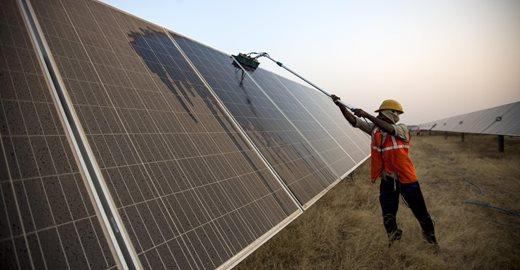
With the increasing emphasis on sustainability and renewable energy adoption, how does your company approach the integration of solar PV solutions into diverse sectors such as commercial, industrial?
Over the past 2-3 years, with changes in regulations pertaining to open access and power exchanges, and the rollout of green energy initiatives such as RE100 at the global level, large industrial and commercial consumers have evinced interest in sourcing clean energy directly from renewable energy producers Apraava Energy was, till recently, focused on utility-scale generation projects mainly because of the relatively smaller size of opportunities in the open access segment Selling power to non-utility customers is one of the key elements in Apraava’s future growth plans, and we will be building a pipeline of wind and solar projects to cater to both utility and non-utility customers
The success of the ongoing energy transition hinges on ‘on-demand’ availability of renewable energy, which is only possible with the help of cost-effective and reliable energy storage systems Utilities are increasingly demanding renewable energy as per their requirements either on a round-the-clock basis or to meet peak consumption requirements The deployment of energy storage solutions in India is facing delays as it could lead to a tariff increase of 1-2 rupees per unit.
Apraava Energy will focus on Battery Energy Storage Systems (BESS) and Pumped Hydro Systems We are actively considering some pilot projects and development opportunities in both these segments We will apply the learnings to future planning and development of integrated renewable-energy-and-storage projects

As India moves towards achieving its ambitious renewable energy targets, what role do you see solar PV developers playing in accelerating the country's transition to clean energy, and what are your company's contributions towards this collective goal?
Apraava Energy is committed to supporting India’s energy transition, helping the country achieve its net-zero targets, investing in noncarbon-emitting businesses and contributing to nation-building We are one of the few players in the industry whose SBTi goals have been successfully validated We are also an active member of leading associations such as the International Solar Alliance (ISA), the Confederation of Indian Industry (CII), Wind Independent Power Producers Association (WIPPA), and the Electric Power Transmission Association (EPTA). We leverage these platforms to raise and resolve issues that impede the transition to clean energy


How do you perceive the role of green hydrogen in India's energy transition, and what opportunities do you see for its integration into the market?
Green hydrogen is crucial in driving the energy transition, particularly if its price can match or undercut traditional fossil fuels like petrol and diesel The key challenge lies in accelerating the commercialization of existing research and technologies to make green hydrogen costcompetitive with alternative energy sources
To achieve this, there needs to be coordination and alignment of technologies, resources, and market demand Consumers require assurance of reliable hydrogen supply to confidently adopt hydrogen-powered vehicles such as cars, trucks, and trains This necessitates a collaborative effort involving government support and private partnerships, including blended finance arrangements
Policy initiatives are essential to incentivize and facilitate these collaborations. Initiatives like the Green Hydrogen Mission under MNRE are steps in the right direction, but relying solely on government actions can lead to delays due to policy changes or the need for modifications to expedite implementation.
Private sector involvement can accelerate progress by reducing initial investment barriers Companies stand to benefit from relatively modest initial investments, as returns can be significant This not only - reduces import dependency but also contributes to a cleaner environment, lowers production costs, enhances export competitiveness, and fosters a positive cycle of increased demand leading to lower prices and greater environmental sustainability
Driving India's Green Hydrogen Revolution: Insights on Development, Challenges, and Future Trajectory.
Policy and growth: India targets 500 GW by 2030, leveraging local manufacturing and embracing technological advancements
Streamlining waste-to-hydrogen projects, inter-departmental coordination, and stable policies are essential for green hydrogen infrastructure development
Stay updated on market dynamics, competitor actions, and policy shifts through comprehensive market intelligence, while leveraging scale to cut costs Forge partnerships with tech firms, financers, and governments for resource sharing and innovative financing Focus on technological advancements like cost-effective perovskite cells and efficiency-boosting bifacial panels for enhanced integration and energy production.
What are the key challenges and opportunities for scaling up green hydrogen production and utilization in India?
Ensuring a reliable connection between supply and demand is critical in the production of green hydrogen Without a secured supply chain, particularly for inputs like biomass used in hydrogen production, companies hesitate to invest in or scale up production facilities Farmers supplying biowaste may increase prices over time once they see demand from hydrogen manufacturers, leading to volatile production costs
Similarly, advancements in technology can bring down production costs for hydrogen, akin to the scenario in solar photovoltaic (PV) projects where pre-contract agreements were made at ₹6/unit but dropped to below ₹4/unit after project initiation This fluctuation can create uncertainties and necessitate contract renegotiations, highlighting the need for financial support mechanisms like the Viability Gap Funding (VGF) scheme
Initial contracts for green hydrogen may cover a small portion of overall demand (e.g., 10,000 metric tonnes) but serve as a catalyst for further
investment and project development VGF can help bridge cost differentials between green and grey hydrogen to incentivize green hydrogen adoption and scale-up, potentially making it more cost-effective than grey hydrogen in the long run
To support research and rapid commercialization of hydrogen technologies, robust policies and ecosystem development are crucial Early-stage funding for startups (e g , ₹10 to ₹20 lakhs) can yield substantial returns through equity dilution or subsequent investment rounds Additionally, implementing Production-Linked Incentive (PLI) schemes for small-scale hydrogen reforming technologies (e g , steam methane reforming, solar methane reforming, methane pyrolysis) can further accelerate the transition to green hydrogen.
Establishing stable policies and funding mechanisms is essential to minimize legal uncertainties and support the growth of green hydrogen technologies, ultimately driving down costs and fostering a sustainable energy transition


What strategies do you believe are essential for fostering collaboration between public and private sector entities to drive the development of green hydrogen infrastructure in India?
To streamline the ecosystem for waste-tohydrogen projects and other initiatives, coordination between different agencies is crucial Challenges arise when companies face obstacles in acquiring waste materials due to auction requirements or transportation costs. Proximity of production facilities to waste sources is essential to minimize transportation expenses and overall production costs
Inter-departmental and inter-ministerial coordination is necessary for efficient project execution Implementing a single-window clearance mechanism or appointing a dedicated nodal agency can facilitate seamless coordination across departments and ministries This centralized approach would benefit startups, technology providers, and investors by simplifying processes and enabling access to funding, including private sector participation.
Effective policies are essential to streamline coordination and unlock the potential of waste-to-hydrogen projects, paving the way for sustainable and cost-effective solutions in the renewable energy sector
From a regulatory perspective, what policy measures do you think are necessary to incentivize investment in green hydrogen technologies and facilitate market growth?
Today, green hydrogen production primarily relies on intermittent renewable energy (RE) sources like solar and wind, which are available only about 20% of the day To optimize efficiency, reducing the number of electrolyzers required by utilizing concentrated solar power (CSP) with thermal storage can enable 24/7 RE availability, significantly lowering electrolyzer costs by up to 20-30% due to reduced infrastructure and operational expenses.
Encouraging CSP development over solar or wind through supportive policies can drive cost reductions and technology advancements. Implementing ProductionLinked Incentives (PLI) not only for electrolyzers and PV manufacturing but also for solar methane reforming, small-scale steam methane reforming (SMR), rooftop-based CSP, and micro-grid-based CSP systems can further reduce hydrogen production costs and promote cleaner technologies like methane pyrolysis
Policies should prioritize firm and dispatchable power from CSP projects, incentivizing vendors to invest in CSP initiatives, which offer continuous RE power generation This approach is beneficial for India's energy landscape and aligns with sustainability goals.
What do you envision as the future trajectory of green hydrogen development in India, and how can stakeholders contribute to its advancement?
Various technologies co-exist to serve different applications in the green energy landscape For instance, in producing green steel, direct heating methods can be more efficient than separating hydrogen from water Combustion requires both hydrogen and oxygen, and technologies like oxy-hydrogen (brown gas) can generate equivalent heat using smaller amount electricity and without separating Hydrogen and Oxygen especially when combustion heating is required and not specifically Hydrogen This Oxy-hydrogen can be produced efficiently using simple alkaline electrolyzers without membranes required for separation and can reduce air intake for the combustion heating and thus saving lot of energy
In scenarios where power generation is necessary for hydrogen or ammonia co-firing with coal, plasma gasification of waste can produce syngas for direct boiler firing The goal is to select technologies and inputs judiciously to achieve cost-effective and cleaner production While the focus isn't always on achieving 100% cleanliness, even an 80% reduction in environmental impact is significant The objective is to mitigate temperature rises and alter trajectory slopes to ensure minimal long-term global impact, particularly amid increasing heating and cooling demands driven by industrialization Concentrated solar power (CSP) plays a pivotal role here, especially in addressing heating and cooling loads, contributing to a sustainable energy future
"Disclaimer:Viewsexpressedarepersonal"
Stakeholders' active participation and strategic investments will shape the trajectory of green hydrogen in India, driving towards a sustainable and cleaner energy future.


On April 30, 2024, LONGi Green Energy Technology Co , Ltd (hereinafter referred to as "LONGi"), a global leader in solar technology, officially released its performance report for the year 2023 The company achieved a revenue of 129.498 billion yuan, continuing to maintain a scale of a hundred billion in revenue Based on the judgment of risks during the period of rapid changes in technology routes, the company officially announced last year that it would use BC (Back-Contact) technology route to achieve production line renewal; merging the industry's commonality of being affected by cyclical factors, the company adjusted the performance of the period slightly declined
The net profit attributable to shareholders of the listed company for the whole year was 10 751 billion yuan, of which the net profit attributable to shareholders of the listed company after deducting non-recurring gains and losses was 10 834 billion yuan; the comprehensive gross margin was 18 26%, and the return on weighted average net assets was 16 20%

In 2023, China's photovoltaic industry continued to expand, with production of key manufacturing links such as polysilicon, silicon wafers, cells, and modules all experiencing year-on-year growth of over 64%, and the total industry output value exceeding 1 75 trillion yuan However, the company's short-term performance was affected by the cyclical downturn in the industry's industrial chain value and the replacement of old and new production capacities
By the end of 2023, the company's self-owned silicon wafer production capacity reached 170 GW, the cell production capacity reached 80 GW, and the module production capacity reached 120 GW In 2023, the company conducted impairment tests on assets showing signs of impairment and proposed to set aside an impairment provision of 7 billion yuan, which mainly includes inventory write-down provisions of 5 2 billion yuan and fixed asset impairment provisions of 1 6 billion yuan At the same time, affected by the continuous decline in product prices at various stages of the photovoltaic industry chain, the company's provisions for inventory and other assets increased accordingly.
In the first quarter of 2024, the company achieved shipments of 26 74 GW of monocrystalline silicon wafers (12 43 GW sold externally), a yearon-year increase of 12 26%; achieved 1 51 GW of monocrystalline cells external sales; achieved 12.89 GW of monocrystalline module shipments
(12.84 GW sold externally), a year-on-year increase of 16.55%, and achieved a revenue of 17 674 billion yuan, a year-on-year decrease of 37 59% LONGi's chairman, Zhong Baoshen, stated that the company's overall business for the year will show a trend of being lower in the first half and higher in the second half, with a gradual increase quarter by quarter. LONGi's overall shipment growth rate for the year will not be lower than the industry average, and the product shipment volume will continue to grow
During the reporting period, facing a market environment where new market opportunities and supply and demand pressures coexist, LONGi maintained a high intensity of R&D investment, driving product cost reduction and efficiency improvement through innovation, and technological upgrades and iterations, to build the company's differentiated competitive advantages From the listing in 2012 to the end of 2023, the company has accumulated R&D investment of more than 27 billion yuan, and has obtained 2879 patents of various types The R&D investment for the whole year of 2023 was 7 721 billion yuan, accounting for 5 96% of the revenue
The pace of commercializing scientific and technological achievements accelerates, with new products anchoring the source of value growth
Nowadays, the products and services provided by various solar manufacturers are becoming increasingly homogenized, with technological upgrades largely based on the same technical direction and platform There is no significant difference between the products of different companies, leading to fierce price competition The industry has reached a consensus that advanced production capacity will never be excessive.
The fruit of three years of dedicated research and development, LONGi released the TaiRay silicon wafer product in March 28, 2024 It has rare advantages such as full platform support, high resist and excellent impurity absorption effects, achievin the substantial innovation of silicon wafers that ha nearly a decade, and is expected to go into mas second quarter of this year The 2023 Annual Re company has successfully developed the HPBC 2 0 achieve a module power that is more than 5% hig same specification TOPCon modules, increasing th of the power station over its entire life cycle by 6 5% gradually introduce mass production in the sec Chairman Zhong Baoshen once stated that the com the transformation of PERC production capacity, and in a very significant leading position by 2025
Leading companies have a significantly higher risk than second and third-tier companies In 2023, a announced the BC (Back-Contact) technology rou been highly recognized globally Only half a yea production, the monthly shipment scale exceeded the principle of leading and expanding product technology, LONGi has accelerated the pace scientific and technological achievements, a production capacity with differentiated competitiv looking forward to Over the next three years, the c to achieve an annual production capacity of 200 GW silicon wafers, of which the "TaiRay" silicon wafer will account for more than 80%; the annual produc (Back-Contact) cells will reach 100 GW; and the capacity for monocrystalline modules will reach 150
In response to the continuous upgrading of BC (Back-Contact) technology products and the development of next-generation technology, LONGi continues to track and invest in technical routes such as TOPCon, HJT, and tandem, achieving outstanding results in the development and introduction of mass-produced cell technology, breakthroughs in the efficiency of new types of high-efficiency cells, and the development and design of new products tailored to customer needs The company has set world records for both the back-contacted crystalline silicon heterojunction solar cell with an efficiency of 27 09% and the crystalline-silicon-perovskite tandem cell with an efficiency of 33.9%, further consolidating the company's R&D strength and cuttingedge technical reserves
Founded in 2000, LONGi is committed to being the world’s leading solar technology company, focusing on customer-driven value creation for full scenario energy transformation
Under its mission of 'making the best of solar energy to build a green world', LONGi has dedicated itself to technology innovation and established five business sectors, covering mono silicon wafers cells and modules, commercial & industrial distributed solar solutions, green energy solutions and hydrogen equipment The company has honed its capabilities to provide green energy and has more recently, also embraced green hydrogen products and solutions to support global zero carbon development. www.longi.com
LONGi's vision extends beyond the horizon, with ambitious targets set to dominate the solar landscape, showcasing an unwavering commitment to pushing the boundaries of efficiency and sustainability
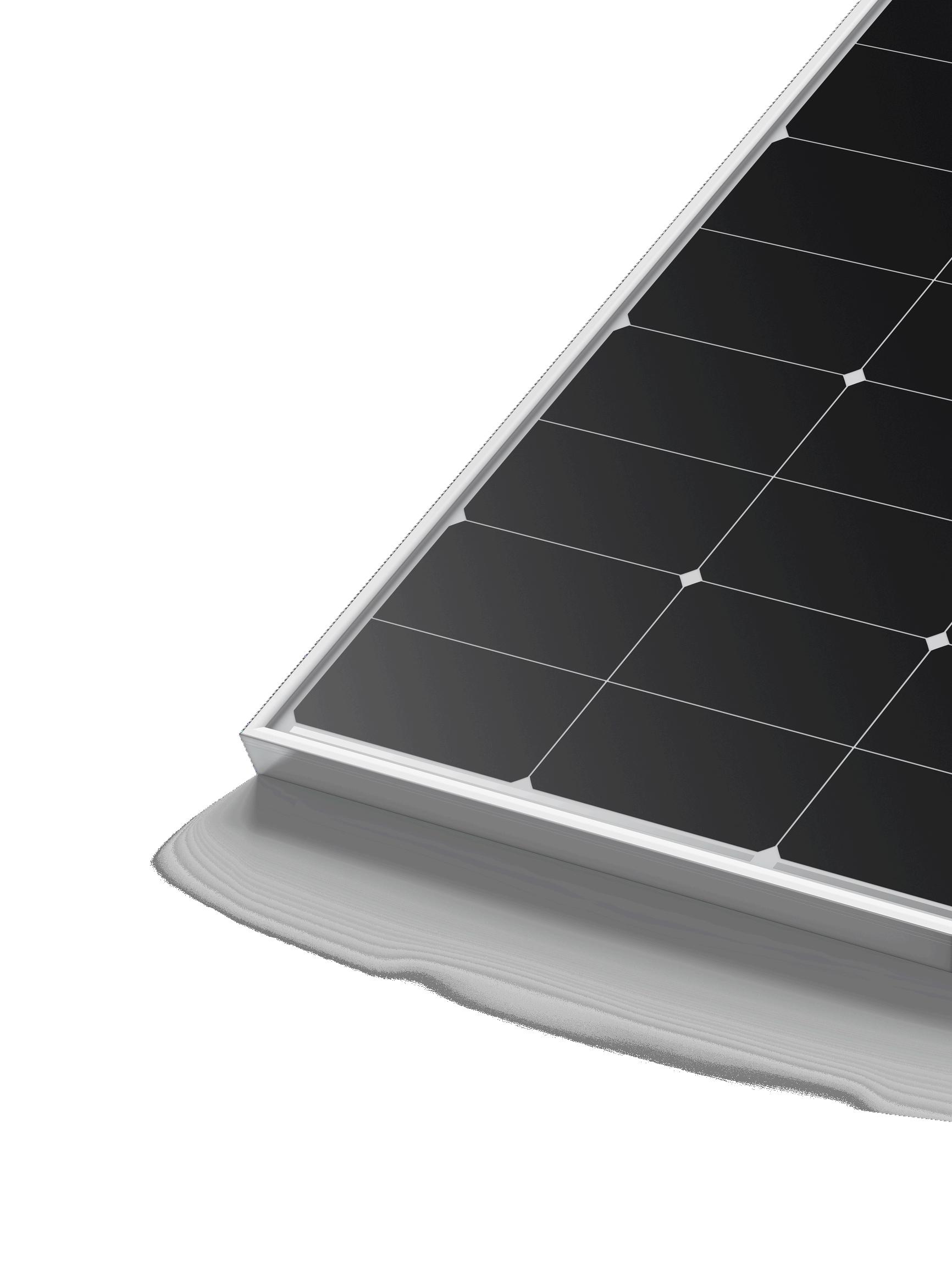




also provides opportunities for asset managers to participate in ancillary services markets, such as frequency regulation and peak Tshaving The declining costs of battery technologies are making these integrations more financially viable, further driving their adoption

In recent years, India has witnessed a significant transformation in its energy sector, with solar power emerging as a vital component of the country's renewable energy landscape. Solar asset management has become a critical focus area as India continues to scale up its solar capacity to meet ambitious renewable energy targets
Solar asset management involves overseeing the operational and financial performance of solar power plants to maximize their efficiency and profitability With the growing number of solar installations across the country, effective asset management practices have become essential for ensuring the long-term sustainability of these projects


In the financial domain, solar asset management in India is witnessing increased interest from investors The stable cash flows and long-term power purchase agreements (PPAs) associated with solar projects make them attractive investment opportunities Asset managers are now focusing on optimizing financial performance by refinancing projects, negotiating better PPA terms, and exploring revenue diversification through participation in green certificates and carbon credit markets. The involvement of institutional investors and private equity firms is also contributing to the maturation of the solar asset management market
One of the primary trends in solar asset management in India is the increasing adoption of digital technologies Digitalization plays a crucial role in monitoring and managing solar assets, enabling operators to gather real-time data on plant performance, detect issues promptly, and implement corrective measures Advanced analytics and predictive maintenance tools help in identifying potential problems before they escalate, reducing downtime and improving overall efficiency The use of drones and automated inspections has also gained popularity, offering a cost-effective and accurate method for assessing the condition of solar panels and infrastructure
Another significant trend is the growing emphasis on performance optimization Solar asset managers are focusing on enhancing the performance ratio (PR) of solar plants, which measures the efficiency of converting sunlight into electricity By analyzing data from various sources, including weather patterns, energy output, and equipment performance, managers can identify opportunities for improvement This includes optimizing the tilt and orientation of solar panels, implementing cleaning schedules to remove dust and debris, and upgrading components to more efficient technologies
he integration of energy storage solutions with solar projects is also gaining traction Battery storage systems help in balancing the intermittent nature of solar energy, ensuring a steady supply of power even during non-sunny periods This not only enhances grid stability but
Policy and regulatory developments are playing a crucial role in shaping the solar asset management landscape The Indian government has introduced various initiatives to promote renewable energy, such as the National Solar Mission and state-specific solar policies These policies provide a favorable environment for solar project development and encourage best practices in asset management However, challenges such as land acquisition, grid connectivity, and regulatory uncertainties still need to be addressed to ensure the seamless growth of the sector.
The rise of independent power producers (IPPs) and third-party asset management companies is another notable trend As the market evolves, many solar project developers are opting to outsource asset management functions to specialized firms These companies bring expertise in operations and maintenance (O&M), financial management, and regulatory compliance, allowing developers to focus on core activities such as project development and expansion The presence of professional asset management firms is driving standardization and the adoption of industry best practices
In conclusion, the landscape of solar asset management in India is rapidly evolving, driven by technological advancements, performance optimization efforts, financial innovations, and supportive policy frameworks. As the country continues to expand its solar capacity, effective asset management will be crucial for maximizing the potential of solar power and ensuring the long-term sustainability of these investments With the right strategies and continued focus on innovation, India is well-positioned to lead the way in solar asset management, contributing significantly to global renewable energy goals


Sineng Electric, a global leading PV+ESS solution provider, is proud to announce its instrumental role in powering a 641MW solar project in Gujarat, India, part of the 30GW Khavda Solar Park Once completed, the Khavda Solar Park will power 16 1 million Indian homes and stand as the world's largest renewable energy installation.
The 641MW solar project, which is developed and owned by Adani, is expected to generate approximately 1,900,000 MWh of clean energy annually This will significantly offset CO2 emissions by an estimated 913,428 tons each year, equivalent to planting 4,567,124 trees.
Sineng's contributions to the project include the supply of 2,887 units of its cutting-edge 275kW string inverters (SP-275K-INH) Featuring maximum efficiency of 99 03%, 12 MPPTs, and compatibility with bifacial PV modules, Sineng's inverters enhance solar power generation and optimize the LCOE The inverters support up to 24 PV strings, aluminum cable connection, and PLC communication, thus lowering the system costs. Additionally, their IP65 and C5 anti-corrosion protection ratings ensure the system's reliability and longevity
Mr Arun Chaudhary, Head of Sales for North India, emphasized the impact of Sineng's involvement, stating, "With our extensive expertise in utility-scale PV projects, excellent quality assurance, robust supply chain, and localization strategy, Sineng is at the forefront of India's energy transformation We look forward to accelerating the country's journey toward decarbonization and a sustainable future "
Moreover, the project has created over 2,500 jobs during the construction phase, boosting local employment opportunities Sineng will remain dedicated to continuous technological advancements and providing top-notch renewable energy solutions that deliver significant economic and environmental benefits
Sineng Electric's legacy isn't just measured in gigawatts; it's seen in the smiles of millions of Indian families, now empowered by clean, reliable energy, marking a pivotal moment in the global quest for a sustainable tomorrow.
Sineng Electric is the global leading supplier of a comprehensive product portfolio including PV inverters and energy storage systems for utility-scale, commercial, and residential applications, as well as power quality products By establishing four R&D centers and leveraging topnotch resources, Sineng's unwavering commitment to technological innovation has enabled more people to access cost-effective, reliable, and sustainable energy. After the three global manufacturing bases being put into operation, the annual production capacity has reach 50GW Currently, Sineng has earned recognition as a BloombergNEF tier 1 PV inverter maker and has maintained its position among the global Top 10 PV inverter suppliers for 10 consecutive years


EnerMAN Technologies is founded in May 2019, with the vision to “Provide innovative digital products to manage energy and decarbonize the world” EnerMAN is a leading provider of innovative, IoT based AI & ML driven SCADA and Energy Management solutions at affordable prices to the Renewable Energy Industry EnerMAN is contributing towards achieving net zero goal by providing innovative products to digitize Renewable Assets
From data acquisition at the site equipment level, to analysis of data that provides meaningful insights to plant performance & health, EnerMAN provides end to end solutions to digitize and manage PV assets
EnerMAN has successfully deployed ETi-SOL® IoT SCADA Monitoring, Control and Analysis solution to more than 2GW (2000MW) of Solar PV plants and Rooftops, 500+ sites, in 10 countries
EnerMAN’s Software products are Made in India products, which are reliable, easy to use with user-friendly dashboards (GUI), timely & accurate alerts on breakdowns, automated reports, and backed by quick customer service support from professional team.
Company’s broader vision for the renewable energy sector is to “Provide innovative digital products to manage energy and decarbonize the world”
EnerMAN is on a mission to be a global leader for Energy Monitoring & Managing Products and solutions Our goal is to install smart IoT datalogger at plant to get clean live data with zero data loss and store all data in a cloud platform for lifetime of the plant EnerMAN provides Energy Management Dashboards that is simple, easy to use and affordable.
In the first year of operations EnerMAN did lot of retrofit projects
replacing few expensive and nonfunctional SCADA systems which lacked service support and was also very expensive to maintain. Now that we have proven our technical competitiveness, and we have a presence in the global market with our affordable solutions
Our strategy is to partner with local players who have a strong regional presence to expand footprint in the global market.
EnerMAN provides end-to-end solutions i e , Hardware, Firmware and Software systems that are developed in-house by an experienced team This removes the dependency on third-party suppliers and helps us sell at an affordable cost.
Our key products:
ETi-LOG: It is an IIoT Data logger, which collects the data through RS 485 (RTU/TCP) from Solar PV plants' end equipment (Inverters, SMUs, WMS, Transformers, Trackers, Breakers/Relay panels) and sends data to Local Server or to the cloud Server. It has built-in storage to ensure no data loss during internet failure
ETi-SOL®: It is a cloud-based software Monitoring platform which acquires data from the field IoT devices for Monitoring, Controlling, Analysis and Reporting (DGR & others reports) of Solar PV plants. It is also a Centralized Monitoring platform -Integrate multiple SCADA into single dashboard Users can monitor through web apps, mobile apps (Android, and iOS) Unlike PLC based SCADA, ETi-SOL does not have any limitations on number of tags being monitored You can read & display unlimited number of parameters from all equipments. ETi-SOL can be integrated with third party SCADA using REST APIs or any other standard data exchange protocols like OPC / FTP


ETi-Edge: It is a local monitoring SCADA solution. Eti-Edge can be installed in a local plant server to avoid data storing in a 3rd party cloud server and no dependency on the Internet
ETi-PPC: It is a Power Plant Control system that will control active power, reactive power, and power factor of Solar Inverters (Solar Plant, Solar-Wind Hybrid Plants) PPC is a combination of Software Logic and Hardware which continuously monitors and controls the Solar inverters
ETi-SLDC: This software product can be installed in local PCs/Servers to collect data from the Solar PV plant’s equipment and can send important processed clean data to SLDC in a few seconds as per SLDC guidelines
ETi-ZES: Zero Export system which will ensure Zero Export from Solar PV plants / Rooftops to Grid, as per DISCOM policy guidelines, to avoid penalty This product collects the data from Solar PV plants' end-equipment and controls/limits the outgoing power of Solar Inverters based on load/consumption at factory/manufacturing unit
ETi-LMS: Load Management System is an IoT Solution for DGSync which is a universal Solution for all Inverter brands (Supports Heterogenous Make) Controls Active Power of Inverters
ETi-CAST: Energy Generation & Forecasting solution, which is a cloud-based forecasting tool for solar power plants/rooftops.
Team EnerMAN has hands on experience building & operating Solar PV Plants & Rooftops The team used their experience to create value for the customer in terms of saving energy, reducing opex and improving plant performance. The business and technology leadership has seen them create innovative products & solutions in the Solar Energy space for more than a decade The core team has many years of global experience in MNCs developing products for the Networking, Telecom, Semiconductor industry. Much of this knowledge about technology & process has been replicated at EnerMAN to churn high class reliable products and solutions
From Rooftops to large Utility PV plants, we have diversified clientele Few of the Solar PV industry leaders from prestigious Govt organizations with whom we are proud to associate with are BHEL, BEL, NTPC, HAL, MES, NFC, AIIMS, IISc, NLC & GSECL in India. Apart from this we have also deployed our solutions to many top private industry leaders
Apart from this, our Wind-Solar Hybrid PPC (Power Plant Controller) solution is implemented in some of the Wind-Solar Hybrid plants in Karnataka and our PPC is implemented on 350MW single largest plant in Kurnool, AP. And apart from this our PPC solution is successfully functioning in GSECL - 50MW plant in Gujarat
For more information regarding our solutions email sales@enerman in or login to www enerman in



The Indian Central Govt launched the National Solar Mission in January 2010, under which the total installed capacity target of 20 GW by 2022 and in 2015, it is further increased to 100GW Later in August 2021, the govt increased the target to 300 GW for 2030 & now India aims at the target of installed renewable capacity of 500GW by 2030 Integrating a large amount of renewable energy such as wind or solar PV power adds several challenges as they depend on the availability of natural resources that fluctuate constantly, making them unpredictable. To promote renewable power integration, it is important that renewable power plants contribute positively to grid stability, especially during system disturbances “There needs to be a balance in production and consumption within an electrical grid” In other words, energy generation must be equal to energy consumption
For the stability of the grid, there must be a balance between the demand and supply of electricity at all points of time. If the demand is more than the supply, the frequency and voltage would dip, and vice versa In extreme cases, it may lead to tripping of the entire grid unless load shedding is carried out Normally, the Indian grid has two peaks A smaller peak in the morning between 9 to 11 am, when the offices and factories start functioning, and a higher peak in the evening between 7 to 9 pm when the domestic & commercial lighting demand kicks in The demand reaches its lowest point some time in between 1AM-4AM in the night, depending upon industrial development and with variations in weather. For optimum, economical, and efficient operation of the grid, the Electrical energy generation should vary based on the peaks
The generation from renewable energy is highly dependent on the weather conditions, and as it the asset owner, or maintenance team has no control Variations and uncertainty in the generation leads to instability on the grid. Vast mismatch in the generation and demand To overcome this, govt regulatory bodies have defined grid codes to ensure stability and to benefit from renewable plant capabilities
Individual state electricity boards define their grid codes, and all the power producers must adhere and comply to the same Huge penalty is levied on the power producers for non-adherence, and it can lead to isolation from the grid
Power Plant Controller [PPC] is mandatory to be implemented to meet this requirement While there’s no standardized capacity threshold, as it's completely under the state electric judiciary. But normally any solar power plant hits 10MWp+, the requirement for a plant controller becomes important Some of the states in India insist even for 5MW+
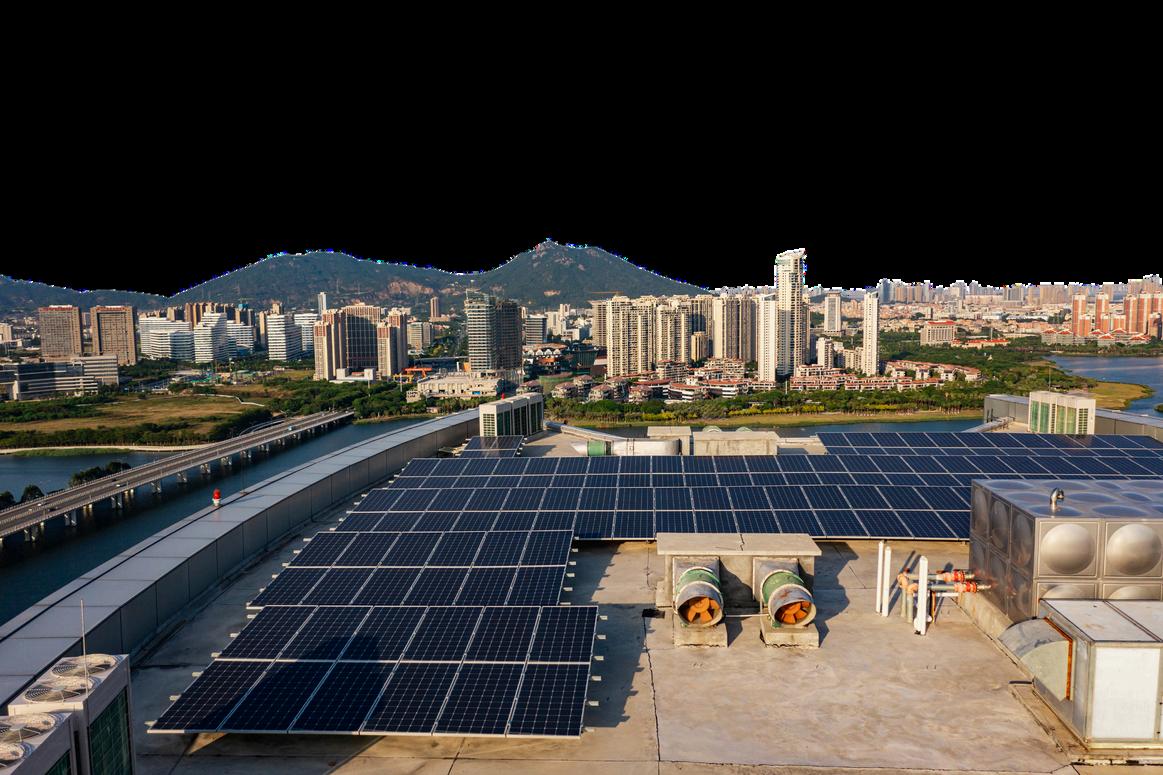
Innovative solutions are essential for grid stability as wind and solar power ' s fluctuating nature challenges supply and demand balance.
Renewable energy integration requires strict grid code compliance to maintain grid stability and optimize renewable plant capabilities.
PPC is a combination of Software Logic and Hardware which continuously monitor the healthiness of grid and automatically acts in case of any abnormality There two types of PPC:
PLC Hardware based PPC which controls the field devices based on the pre-programmed logic in it
IoT Based PPC, which is latest Software logic based PPC which can monitor and control the field devices with pre-programmed logic as well as it supports manual inputs
EnerMAN In-house developed Power Plant Controller [ETi-PPC] can be installed on a server or PC compared to expensive PLC hardware’s and complex logic
It allows user to
Change the Set Point
Control the inverters at Plant lever, block level, and individually
Schedule the control operation
Analyze the trend and download the data
User-Defined Performance Monitoring
Monitor Data Locally and Remotely
PPC What all control EnerMAN ETi-PPC does? Does ETi-PPC ensure grid stability during Non-Generation Hours? What PPC does and what types of PPC in industry?
Active Power Curtailment
Reactive Power Control
Power factor Control
Reactive power Control at night
Automatic Voltage Regulation (AVR)
Yes ETi-PPC’s intelligent Reactive power Control logic monitors the grid data 24x7, and during the night, it controls the inverters and makes work as Capacitor Bank or Inductive Bank as per requirement
EnerMAN ETi-PPC is a Software based IoT Power Plant Controller which can be installed on any Solar PV plant regardless of type of SCADA which has been already installed
EnerMAN’s PPC can be deployed not only to Solar Power Plants It can be deployed to Hybrid Power plants like Solar-Wind, SolarStorage, Etc


In the world of today, climate change is not a hoax but a harsh reality. Collectively, if we don't shift our efforts rapidly towards renewable energy sources, permanent damage to the environment is inevitable For a tropical country like India, solar energy is a gold mine for renewable energy sources Here at Navitas Solar, we are at the forefront of a green revolution. With a commitment to sustainability and conservation, and a knack for innovation, we are transforming the solar industry through cutting-edge solar technologies, specialized solar installation services, and maintenance packages
We were founded in 2013, by five young entrepreneurs with a vision of a greener India Based in Surat, Navitas Solar has made a name for itself, as a key player in the solar energy market The company's core philosophy revolves around harnessing the power of the sun and delivering the most reliable and efficient solar products and services Our expertise lies in both manufacturing solar panels and providing comprehensive solar installation and maintenance services, making us a one-stop solution for homes, businesses, and communities looking to embrace solar energy.
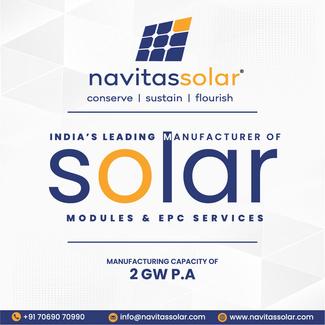

The cornerstone of Navitas Solar's operations is a cutting-edge solar panel manufacturing facility capable of producing 2 GW of power each year Our production facility manufactures high-quality solar PV Modules from 40 Wp to 720 Wp which use multi and mono crystalline we are manufacturing TOPCon too multi/monocrystalline silicon with modern manufacturing techniques and equipment in a clean environment Navitas Solar creates panels that are not only efficient in capturing sunlight but also durable and environmentally benign Innovation is the way forward We prioritize continual research and development to be at the forefront of our industry With a devoted team of engineers and scientists, we are constantly improving the efficiency and performance of their solar panels Through continuing experimentation and collaboration with industry experts, we are always pushing the limits of solar panel technology
Navitas Solar leads the charge in solar innovation, ensuring a greener future for all.
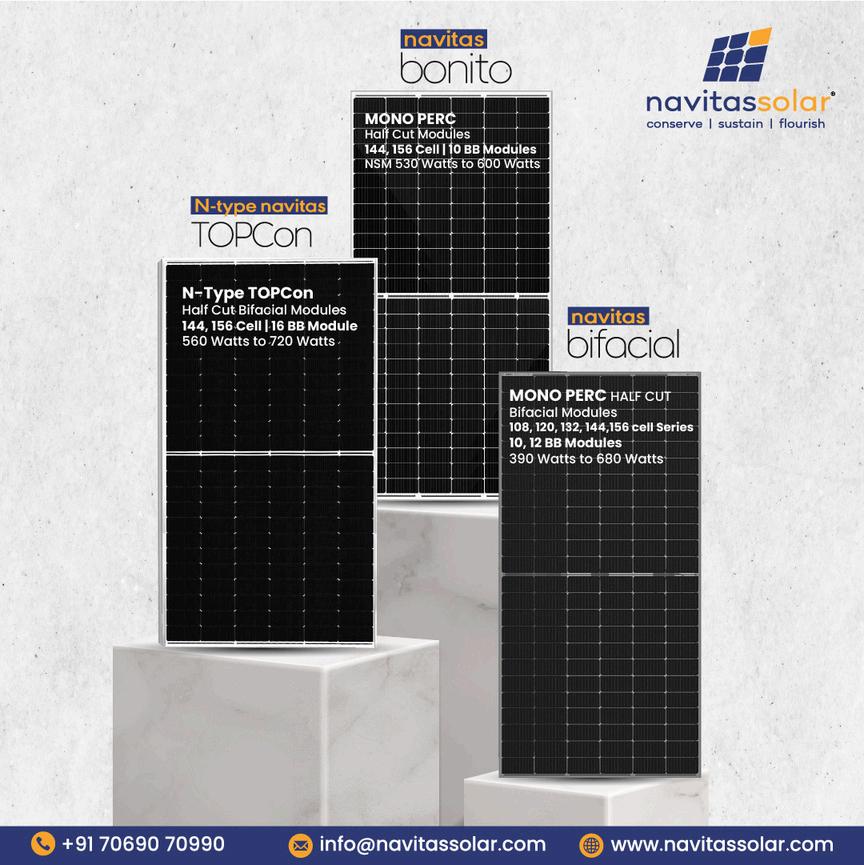

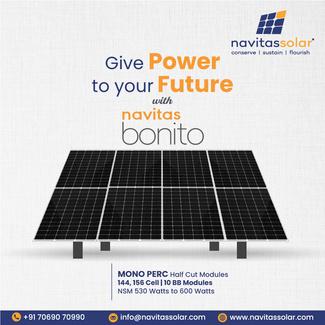

Apart from having state-of-the-art facilities, Navitas Solar prides itself on our comprehensive solar installation services We have assembled a team of skilled professionals who will ensure a seamless transition from purchasing solar panels to the installation process From residential rooftops to large-scale commercial projects, Navitas Solar provides installation services available for a range of applications Our team works closely with clients to understand their energy needs and design customized solar solutions for maximum efficiency Navitas Solar's dedication to quality goes beyond the manufacturing process Each member of their installation team has the required skills and ability to install solar panels in a safe and efficient manner thanks to rigorous training and certification programs By following industry best practices and local requirements, Navitas Solar ensures that every solar installation meets the highest standards, leaving clients satisfied and confident in their decision to embrace solar energy.
Here are some of the products and services we offer: Solar EPC
Manufacturing EVA sheets
To learn more about our services visit our website https://navitassolar.in/
With our hard work and perseverance, Navitas Solar has established itself as an important player in the solar business. The company actively participates in industry events, conferences, and exhibits to share its knowledge and promote the benefits of solar energy, as well as charity activities to educate the next generation about the benefits of solar power By building ties with various industry stakeholders, we actively contribute to the overall growth and development of the solar energy sector
Navitas Solar's purpose is centered on sustainability As a solar panel manufacturer, they understand the importance of minimizing their own environmental impact Navitas Solar assures that its manufacturing operations are as environmentally friendly as possible by using sustainable materials and reducing waste output. Navitas Solar sets a high standard for environmental responsibility, inspiring other companies to follow suit
Our constant pursuit of renewable energy solutions and innovative approaches to harvesting solar power demonstrate our dedication to a sustainable and ecologically responsible future We will continue to help communities and companies adopt clean, green energy by manufacturing cutting-edge solar panels and offering comprehensive installation services We are dedicated to driving the shift to renewable energy by ensuring that every project we undertake represents our core principles of sustainability, efficiency, and environmental responsibility





On behalf of the state leadership, We extend heartfelt congratulations to the winners of the "MEET Rajasthan Industry Leaders" awards Your dedication, innovation, and contributions to Rajasthan's industrial growth are truly commendable. Your hard work has significantly boosted both your businesses and the state's economy.














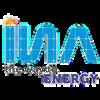































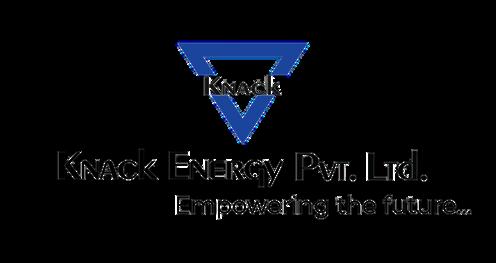






























Solar power in India has seen remarkable growth over the past decade, positioning the country as a global leader in renewable energy adoption This rapid expansion is driven by India's ambitious targets to combat climate change, reduce dependency on fossil fuels, and provide sustainable energy to its vast population However, the sector faces significant challenges in asset management that need innovative solutions to ensure longterm viability and efficiency
One of the primary challenges in managing solar power assets in India is the variability and unpredictability of solar energy production. Solar power generation is inherently dependent on weather conditions, which can fluctuate daily and seasonally This variability complicates the integration of solar power into the national grid, requiring advanced forecasting and energy storage solutions to stabilize supply
Additionally, the sheer scale of solar installations across diverse geographic locations in India poses logistical challenges Maintaining and monitoring numerous dispersed solar farms necessitates robust asset management systems Traditional methods of manual inspections and maintenance are not feasible for large-scale operations Instead, digital technologies and automation are essential to streamline processes and enhance efficiency
The harsh environmental conditions in many parts of India further exacerbate asset management difficulties High temperatures, dust, and extreme weather events can degrade solar panel performance and reduce their lifespan. Regular cleaning and maintenance are critical, yet these activities are resource-intensive
and costly Innovations such as robotic cleaning systems and advanced materials that repel dust can mitigate these issues, ensuring sustained efficiency and reducing operational costs
Another significant challenge is the financial aspect of solar power projects While the initial costs of solar installations have decreased, the long-term financial sustainability of these projects depends on effective asset management Predictive maintenance, driven by data analytics and machine learning, can play a crucial role in this context By analyzing performance data and predicting potential failures before they occur, operators can optimize maintenance schedules, minimize downtime, and extend the lifespan of solar assets
India's solar power sector also faces regulatory and policy-related hurdles Inconsistent policies across different states and complex approval processes can delay project implementation and increase costs Streamlining regulations and providing clear guidelines for asset management practices are necessary to foster a more conducive environment for solar power growth
Innovative solutions are emerging to address these challenges and revolutionize solar asset management in India One such innovation is the adoption of Internet of Things (IoT) technology IoT devices can monitor various parameters of solar panels, such as temperature, voltage, and current, in real-time This continuous monitoring enables early detection of issues and enhances the overall reliability of solar power systems
Artificial Intelligence (AI) and machine learning are also being leveraged to optimize asset management These technologies can amounts of data from solar installations to identify predict maintenance needs AI-driven asset platforms can provide actionable insights, allowing make informed decisions and improve operational

echnology offers another promising avenue for nsparency and traceability in solar power asset By creating a decentralized ledger of all transactions nce activities, blockchain can ensure accountability he risk of fraud. This increased transparency can vestors and boost confidence in the sector
while solar power in India presents numerous asset challenges, innovative technologies and strategies e way for more efficient and sustainable operations on of IoT, AI, machine learning, and blockchain holds significant potential to enhance the reliability, and financial viability of solar power a continues to advance its renewable energy goals, ions will be crucial in overcoming challenges and g ong-term success of its solar power initiatives

Considering India's energy landscape, regulatory environment, and climatic conditions, managing solar assets in India is a dynamic and challenging journey The Challenges can be categorized into three different groups: Legal, Financial, and Technical Some insights to navigate the challenges are as below:

Legal:
Policy and Regulatory Landscape: Policies and regulations governing the solar sector in India are still evolving Changes in subsidies, tariffs, and incentives significantly impact the economics of solar projects Complete awareness and consideration of these at different project stages are necessary for the development and long-term operation of the projects.
Contractual Arrangements: Making precise contractual arrangements with stakeholders, including equipment suppliers, contractors, and off-takers, is the key to mitigating risks and ensuring smooth project execution and operation. Based on past learning where contracts were not owned by different parties, complete and binding contracts are very much necessary
Insurance and Risk Management: Assess and mitigate various risks associated with solar asset management, including equipment failure, natural disasters, and regulatory changes Consider insurance coverage and risk management strategies to protect investments and minimize financial losses
Technical Challenges:
Variability in Solar Resource: India experiences diverse climatic conditions across different regions, leading to variability in solar irradiance levels The unavailability of long-term groundmeasured resource data adds to the error in predicting the resource data The industry is working on adopting advanced forecasting techniques to anticipate fluctuations in solar resource availability and optimize plant operations accordingly
Performance Monitoring and Maintenance: Understanding the need for independent weather monitoring stations in operational
plants and Implementing robust monitoring systems to track the performance of solar assets regularly is the foremost requirement for improving the performance of operating assets Proactive maintenance and timely repairs are essential to ensure optimal performance and maximize energy generation
Technology Adoption: Innovative technologies such as energy storage, robotic waterless cleaning, AI-enabled advanced monitoring systems, and predictive analytics are some of the areas that will help optimize the performance and value of solar assets Continuous innovation is key to staying competitive in the evolving solar market
Ǫuality Control and Compliance: It is essential to meet equipment quality standards and comply with regulatory requirements Poor-quality components may reduce the initial project cost, but they will undoubtedly lead to underperformance, increased maintenance costs, and shorter asset lifespans Ensuring the availability of similar equipment 5-6 years down the line for replacement is already a challenge for the entire industry.
Financial Challenges:
Financing and Investment: As a rapidly growing industry, securing financing and investment is critical for scaling up solar projects in India The availability of low-cost debt financing is one key aspect of developing profitable projects Other financial instruments include re-financing, Green bonds, and government incentives, which are helping the industry grow at a rapid pace.


India’s utility scale solar is now swamped with international investors, who have brought down the IRR expectations to 12-14% With such low margins between cost of capital and IRRs, and single solar spreading across hundreds of acres, solar asset management has become more crucial than ever. Coupled to that is the integration of automated trackers, energy storage and requirements of scheduling and forecasting, which make the process even more complex
India’s RE systems used to comprise of a traditional brick and mortar setup, who used to install power projects in expectations of a decent return However, with advancement in technology and highly dynamic energy market, the ecosystem is evolving to a tech- backed market Government of India’s drive to install smart metering across the country will lead to more flow of data and better energy management.
There is no better time for developers to include AI/ML based asset management systems in their O&M process With several variables affecting solar generation, it is almost impossible to manage the O&M without artificial intelligence, which helps the developers in not just pointing out the root cause of any fault, but also in predictive maintenance of solar panels Given the scale of solar projects, the cost of such AI/ML based systems also spreads over hundreds of megawatts, and such cost can be recovered by just efficiently planning the solar panel cleaning

Using AI, companies can predict when the equipment is likely to fail or need maintenance ML can analyse large amounts of data from various sources, including historical records and weather monitoring, to predict potential breakdowns, thus minimising downtime and improving reliability.

Energy storage and hybrid RE projects, while adding to complexity of operations, can be better managed through AI IPPs are already considering the scenarios where scheduling and forecasting of RE projects can be better managed through energy storage, and AI/ML based systems can be handy in processing large amount of data from various sources and automatically storing and releasing energy from BESS systems installed The environment is poised to make RE as a firm source of power, backed with storage, and this level of sophistication is unachievable without artificial intelligence backed technology
Not just the solar developers, but other agencies in the ecosystem –utilities, load dispatch centres, transmission companies – would also need to incorporate these advanced technologies to process, analyse and make decisions in real time With increasing number of grid-scale and distributed RE systems, such agencies would need to manage the generation, transmission, and distribution through AI/ML based applications to avoid grid outages and failures
Of late, there has been huge interest of investors in cleantech space, and many Indian and international companies have leveled up the asset management space by introducing advanced technologies. India is poised to see a drastic change in the ecosystem while covering the journey to 500GW of renewable energy



Technological innovations in the space of Asset management are relatively naïve, currently The focus till date is being towards more and more deployment of solar plants/assets rather than a focused R&D for optimizing production capability from the same plant/asset
As per our market insights, up to 20% of all rooftop solar systems in India have exposed or faulty wiring posing a high to severe risk to the roofs and even public Even Solar EPC Companies are not addressing Post Solar Installation experience for their end customers, except for a very few. Companies built to address this gap by providing an integrated approach on Asset management related services for their end consumers- will definitely have an edge over others
The below simple and smart solutions, if implemented by operators and owners of Solar Assets - can not only ensure their plant uptime but also build a robust post installation experience:
Building a Central Monitoring Dashboard at Portfolio level:
The first step is to bring all assets on a central dashboard For easy management of analysing site performances all sites should we on a central dashboard of any Monitoring and Maintenance portal Having a single IoT partner with a long-term vision will help an operator built your central dashboard at no extra cost viz a viz deploying at a later stage
Ensuring Data Uptime & seamless communication to loggers:
This can be ensured by installing robust hardware devices which ensure seamless data communication (through GSM/LAN) in all environments Ensuring no breakage in communication and data uptime will limit your service calls requirements
Building O&M Scheduling and Reporting tools/Ticketing on the same dashboard:
O&M team handling all Preventive & Breakdown Maintenance of sites with proper reporting mechanism ensures effective tracking of historic faults and the frequency of their occurrences This will help reduce the post sales visits and identification of critical faults.
One-time Site Health Check-ups:
A detailed technical analysis on Preventive Maintenance check list for all sites every 2-3 years is critical and providing proactive component replacements
Inverter Maintenance:
Inverters are critical components of solar systems Schedule regular inspections and maintenance for inverters to ensure they are functioning correctly
By implementing these cost-effective maintenance strategies, owners and operators can optimize the performance and longevity of their solar assets while minimizing sudden unexpected expenses
To conclude, a stable monitoring platform with a robust hardware device and uninterrupted network communication to the central dashboard Plus a trained O&M team that ensures the above simple guidelines; will help attain the best Asset management practice in the most cost effective way.

Director
Asun Solar Power Pvt. Ltd. & Intello Tech AMC Pvt. Ltd.
This article explores cost-effective maintenance strategies for the crucial components of solar facility.
Regular Inspections: Twice a year, conduct a meticulous inspection of solar modules. Looking for signs of trouble like cracks, discoloration, or hot spots (areas with significantly higher temperatures) Early detection allows for prompt repairs, preventing minor issues from cascading into bigger problems and expensive replacements This can be achieved by visual inspection and drone thermography
Embrace the Power of Cleanliness: Dust, grime, and bird droppings can significantly reduce sunlight absorption and radiation level to module, hindering and reducing energy production
Ensuring Inverter Efficiency:
Don't Skip Monitoring: Inverters are the workhorses of a solar system, converting direct current (DC) from the panels into usable alternating current (AC) Regularly monitor inverter performance data, keeping an eye on metrics like output voltage and current Deviations from normal values might indicate potential issues Monitoring the daily generation and tracking the periodical preventive maintenance activities like filter cleaning, IGBT dust removal to ensure high uptime
Cooling Counts: Inverters can lose efficiency when they overheat Ensure proper ventilation around inverters and consider upgrading the cooling system if necessary This proactive approach can prevent costly inverter failures down the line Specially in summer season, we can increase the frequency of filter cleaning
Maintaining Transformer Reliability:
Oil Analysis is Key: Transformers rely on insulating oil to function properly Schedule periodic oil analysis to identify signs of contamination. Early detection allows for oil filtration or replacement, preventing transformer failure and the associated downtime and repair expenses This is achieved with different tests like BDV, DGA, Tan delta on periodic basis that gives the transparent information of oil condition and take the necessary action before and tripping or minimising the downtime
Listen Up: Transformers can make a faint humming noise during operation However, unusual noises like buzzing or crackling could indicate loose connections or internal faults. Address these issues promptly to prevent transformer damage With the help of visual inspection, we can check any oil leakages through valve, any loose nut bolts and take the necessary preventive action to tighten and resolve the same
Securing the Foundation: Civil Structure Maintenance:
Visual Inspections: Regularly inspect the mounting system, racking, and overall structure for signs of corrosion, loose bolts, or any deformation Promptly address any issues to ensure the structural integrity of the solar array and prevent potential panel damage from wind or seismic activity It is usually affected highly during the seasonal tilts, hence post tilting we need to ensure the

proper tightening of the MMS structure so that if in case during high wind the structure is not damaged and therefore loss to asset
Drainage Matters: Proper drainage is crucial to prevent water pooling around the solar farm, which can lead to foundation erosion or damage to electrical components Regularly check for clogged drains and ensure proper water flow away from the structures Hence as a preventive action pre monsoon need to check all the water drainage system and maintain the proper flow of water to avoid any adverse effect on the assets
Additional Tips for a Cost-Effective Approach:
Investment in drone based Thermal Imaging: Thermal imaging cameras can detect hotspots within a solar array, pinpointing potential problems before they snowball into major issues While the upfront cost might seem high, early detection and repair can significantly reduce long-term maintenance expenses We can have drone-based thermography which will give results within short period of time and categorise the possible faults in the modules like Diode failure, Single/Muti cell hotspots
Embrace Digital Tools: Cloud-based monitoring systems offer realtime performance data and anomaly detection, enabling remote monitoring and early issue identification This can significantly reduce the need for frequent on-site inspections, leading to cost savings Implementation of central monitoring system from Inverter to module level can help to minimize the time taken to attend any fault possibility and take preventive action against the same.
Standardize Parts Inventory: Maintaining a small inventory of critical spare parts for inverters and transformers can minimize downtime in case of emergencies This can be particularly important in remote locations were waiting for replacements might be time-consuming. Specially for a large portfolio we can maintain state wise inventory or region wise inventory so that whenever there is any breakdown then it can reach fir replacement within minimum time
Expert Team monitored at HO level: A expert team specially for carrying and tracking maintenance for all the assets built and reporting at HO level so that there is transparency from HO to site level and whatever assistance is required can be shared within short time.
By following these cost-effective maintenance strategies, solar asset owners and operators can ensure their solar farms continue to generate clean energy for years to come. Remember, a proactive approach is key to maximizing return on investment, minimizing downtime, and keeping your solar power plant shining brightly



Asset Management is a holistic concept that seeks to optimize the long term returns on investment for the portfolio In accounting parlance, an asset is anything that is expected to yield financial benefits in future over an extended period of time. In this industry the upside is usually predetermined while the downside is a probabilistic estimate with a risk of potentially unknown variables So, while the returns are uniform at best, the risks increase exponentially over time
Solar Asset Management starts with the understanding what an ‘asset’ is comprised of:
The physical equipment with relevant approvals to operate at full capacity
The contractual asset that gives the right to revenue (the PPA) and
The client i e the consumer of the energy who is expected to survive and thrive through the term of the PPA and honour the contract throughout its term
Asset Management stands on 4 legs:
Development: includes risk assessment (credit risk and regulatory risk), site assessment, resource assessment, yield assessment, demand pattern assessment, PPA negotiation and closure, financing, EPC, obtaining regulatory approvals, quality management and the eventual handover of the asset to the asset managers. Even though asset managers are generally not directly involved in the development activities it is critical for them to be aware of each of these elements in a systematic manner so that they understand the risk-return framework that they are going to manage They are also expected to have an overall portfolio view
Employment: includes keeping the asset operational i e plant is operational (through thorough preventive maintenance), tracking consumer’s energy demand (relocating the plant if need be to align with the client’s business) and enforcing the PPA amicably
Productivity: includes maximizing the returns from the assets while they are employed i e closely monitoring performance parameters, optimum cleaning, optimum energy production, optimum maintenance, spares and warranty management, timely energy billing, timely revenue collection, active client relationship management, and active regulatory environment management
Sustainability: includes making sure that the asset survives its intended life in good health i e keeping assets insured, periodic quality checks, development of vendor ecosystem, periodic engagement with client decision makers, proactive dissemination of data and analysis to relevant stakeholders, creation of feedback loops, design and deployment of an optimum ESG management strategy, adhering to statutory compliances and adoption of fair business practices
Asset Management is a more strategic and commercial concept rather than tactical or operational one, though on a day-to-day basis one may get the impression of it being a tactical affair An Asset Management strategy which is piecemeal or short sighted is bound to dilute and collapse over time and create a near irreversible mess Asset Managers are expected to be forward-looking and own their portfolio at all point of time This can sometimes bring them into conflicts with other teams whose objective is more time bound and immediate. Mature asset managers look to find a balance and adopt sustainable solutions rather than short term fixes
At Fourth Partner Energy, we have a dedicated Asset Management team that comprises of our core managers, Service engineers and technicians to ensure that our Clients benefit from maximised generation across our RE plants

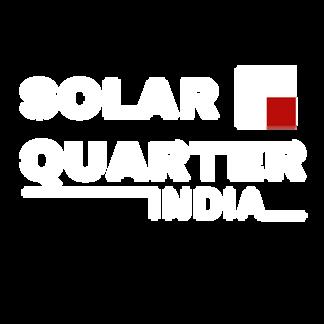




The solar energy sector in India is expanding rapidly, driven by ambitious renewable energy goals and the increasing need for sustainable power solutions As solar projects grow in number and scale, navigating regulatory challenges becomes essential for effective solar asset management Ensuring compliance with a complex regulatory framework while maximizing returns on investment is crucial for the long-term success of solar ventures
Regulatory compliance is a cornerstone of solar energy projects. Various national and state regulatory bodies oversee solar installations, each with specific rules and guidelines These regulations cover land acquisition, environmental clearances, grid connectivity, and tariff structures Understanding this legal landscape and proactively engaging with regulatory authorities is critical for avoiding delays and ensuring project success
Land acquisition is one of the primary regulatory challenges in solar asset management Acquiring land can be a lengthy and complex process involving multiple stakeholders, including landowners, government agencies, and local communities Ensuring compliance with land use regulations and resolving any legal disputes promptly is crucial to prevent project delays Solar asset managers must conduct thorough due diligence and engage in transparent negotiations to secure land legally and ethically.
Grid connectivity is another critical regulatory aspect Solar projects must be connected to the national or state grid to distribute the generated electricity This requires adherence to technical standards and protocols set by grid operators and regulatory commissions Delays in obtaining grid connectivity approvals can impact project timelines and financial returns Asset managers need to collaborate closely with grid operators and ensure all technical requirements are met for seamless integration.
Tariff regulations significantly influence the financial viability of solar projects Tariffs for solar power are often determined through competitive bidding processes regulated by government bodies Ensuring compliance with tariff guidelines and securing favorable power purchase agreements (PPAs) is essential for maximizing returns Asset managers must stay informed about tariff trends and regulatory updates to strategically position their projects in the market
To navigate these regulatory challenges effectively, solar asset managers should adopt several best practices Firstly, engaging with legal experts specializing in renewable energy regulations can provide invaluable guidance. These experts can help interpret complex regulations, identify potential compliance issues, and develop strategies to address them proactively.
Maintaining open lines of communication with regulatory authorities is crucial Regularly updating authorities on project progress and seeking clarifications on regulatory requirements can help prevent misunderstandings and delays Building positive relationships with regulators can also facilitate smoother approval processes
Leveraging technology can enhance regulatory compliance Digital tools and platforms can streamline documentation, track regulatory changes, and ensure timely submissions of required reports and applications. For instance, software solutions for environmental monitoring and grid integration can help asset managers maintain compliance with technical standards and environmental norms.
Maximizing returns in solar asset management involves not only ensuring regulatory compliance but also optimizing operational efficiency and financial performance This includes regular maintenance of solar assets to enhance performance, adopting advanced technologies to improve energy output, and exploring financial instruments to manage risks and secure funding
In conclusion, navigating regulatory challenges in solar asset management is a multifaceted task requiring strategic approaches and proactive management. Ensuring compliance with land, environmental, grid, and tariff regulations is essential for the smooth operation and financial success of solar projects. By engaging with legal experts, maintaining open communication with authorities, leveraging technology, and investing in staff training, solar asset managers can effectively navigate the regulatory landscape and maximize returns on their investments As the solar energy sector continues to grow, these strategies will be crucial for sustaining momentum and achieving longterm success in the renewable energy market



India's ambitious renewable energy targets, with solar at the forefront, have propelled the nation into a solar boom While this rapid expansion brings immense potential, it also raises critical questions about the long-term health and performance of these assets In this column, explore how government initiatives and regulations are shaping the landscape of solar asset management in India
Financial Incentives
Schemes like the Production Linked Incentive (PLI) promote domestic manufacturing of high-efficiency solar panels This initiative reduces dependence on imports and incentivizes the use of high-quality components, ultimately leading to better-performing and longer-lasting solar assets By encouraging local manufacturing, the PLI scheme ensures that solar panels are tailored to the specific needs and environmental conditions of India, enhancing their durability and performance
Skill Development Programs
Recognizing the need for a skilled workforce, the government supports various training initiatives for solar technicians and engineers. These programs ensure a pool of qualified personnel equipped to handle operation and maintenance (O&M) tasks effectively With a skilled workforce, solar plants can operate at peak efficiency, and their lifespan can be maximized Continuous education and training are crucial to keeping up with technological advancements and best practices in the industry
Data Sharing and Standardization
The Ministry of New and Renewable Energy (MNRE) promotes datasharing platforms for solar plant performance. This transparency allows asset managers to benchmark their operations against industry best practices, identify areas for improvement, and foster knowledge exchange within the sector Standardized data collection and sharing enhance the ability to analyze performance trends, predict maintenance needs, and implement proactive measures to optimize plant operations
Regulatory frameworks like the Rooftop Solar Guidelines and Grid Standards for Solar PV systems establish quality benchmarks for equipment and installation practices These standards ensure the use of reliable components and adherence to established safety protocols, ultimately leading to more robust and less failure-prone solar assets By enforcing these quality standards, the government ensures that solar installations are not only efficient but also safe and durable
Regulatory Framework Shaping Asset Management Practices
planning and investment in O&M practices, as asset performance directly impacts project profitability Distribution companies are thus motivated to maintain their solar assets efficiently to meet the RPO requirements and maximize returns


This policy promotes rooftop solar installations for residential and commercial buildings To ensure long-term system viability, regulations often mandate periodic inspections and maintenance by qualified personnel This encourages the development of a robust asset management ecosystem for distributed solar systems, ensuring consistent performance and longevity of rooftop installations
As the share of solar power in the national grid increases, grid stability becomes paramount. Regulations governing grid integration consider factors like forecasting, scheduling, and power quality. These regulations indirectly influence asset management practices, requiring operators to invest in advanced monitoring and control systems to ensure smooth grid integration and optimal plant performance Effective grid management ensures that solar power can be reliably incorporated into the national grid without causing disruptions
While government initiatives provide a strong foundation for effective solar asset management, challenges remain Policy consistency and long-term vision are crucial to attract investment and incentivize best practices Additionally, streamlining regulations and bureaucratic processes can expedite project development and ensure timely maintenance activities Overcoming these challenges will require continuous collaboration between the government, industry stakeholders, and investors
India's policy framework plays a critical role in shaping the future of solar asset management. By fostering innovation, promoting skill development, and ensuring the quality and reliability of solar assets, government initiatives can contribute significantly to the long-term success of India's solar revolution Continuous policy evaluation and refinement will be vital to address emerging challenges and ensure India's solar journey remains sustainable and efficient As the nation progresses, these regulatory measures will help maximize the returns on solar investments and support the broader goal of a renewable energy-powered future


India, with its ever-growing energy needs and sunshine-rich landscape, is experiencing a solar boom This rapid expansion necessitates robust asset management strategies to ensure the longterm viability and efficiency of solar power plants. This column explores key considerations for asset managers navigating this dynamic sector
The Indian government has set ambitious renewable energy targets, with solar playing a pivotal role Favorable policies, falling solar panel costs, and increasing investor interest have fueled a surge in solar power generation capacity This rapid growth presents both opportunities and challenges for asset managers
Effective asset management encompasses the entire solar project lifecycle, from planning and construction to operation and maintenance (O&M). Asset managers need to establish protocols for performance monitoring, preventive maintenance, and timely repairs to maximize energy output and extend plant life. Solar power plants generate a wealth of data Asset managers can leverage data analytics to gain insights into plant performance, identify potential issues like equipment degradation, and optimize operations for maximum efficiency This proactive approach can minimize downtime and ensure plants operate at peak capacity
Solar projects are susceptible to various risks, including weather fluctuations, grid instability, and component malfunctions Asset managers need to develop comprehensive risk mitigation plans that address these potential challenges This may involve insurance coverage, diversification of project locations, and robust O&M practices. The solar industry is constantly evolving, with new technologies emerging regularly. Asset managers must stay abreast
of these advancements and assess their suitability for existing and future projects This could involve integrating advanced monitoring systems, exploring battery storage solutions, or adopting automation for O&M tasks.
Effective asset management requires a skilled workforce Recruiting and training personnel with expertise in solar technology, data analysis, and maintenance is crucial Continuous training programs ensure staff remain updated on the latest advancements and best practices in the field Optimizing asset performance translates to financial benefits Asset managers need to consider the cost of operations, potential upgrades, and decommissioning plans throughout a project's lifespan Implementing strategies that balance long-term asset health with financial sustainability is essential
By adopting a comprehensive approach that addresses these key considerations, asset managers can navigate the Indian solar boom and ensure the success of solar power plants. Effective communication and collaboration between asset managers, developers, equipment manufacturers, and power distribution companies are essential for smooth project execution and optimal plant performance Developing standardized processes for O&M, data analysis, and risk management across projects can improve efficiency and ensure consistency Embracing new technologies and adopting a long-term perspective on asset management is crucial for maximizing the benefits of solar power in India's energy mix
India's solar boom presents a unique opportunity to tap into a clean and sustainable energy source. By implementing robust asset management strategies, stakeholders can ensure the long-term viability and efficiency of solar power plants, contributing significantly to India's renewable energy goals

In the dynamic landscape of India's solar energy sector, efficient management of solar assets is crucial for maximizing energy output and returns on investment. As the country strives to meet ambitious renewable energy targets, leveraging data-driven insights has emerged as a game-changer in optimizing the performance and longevity of solar installations
Solar asset management involves the comprehensive oversight of photovoltaic (PV) systems throughout their lifecycle, from installation and commissioning to operation and maintenance Traditionally, asset managers relied on periodic inspections and manual monitoring to ensure system efficiency However, the advent of advanced data analytics and IoT (Internet of Things) technologies has revolutionized this approach
One of the primary benefits of data-driven insights in solar asset management is proactive maintenance By continuously collecting and analyzing real-time data from sensors embedded in solar panels, inverters, and other components, asset managers can detect anomalies or performance deviations promptly This early detection enables timely intervention, preventing potential failures and minimizing downtime, thereby optimizing energy generation
Moreover, predictive analytics plays a pivotal role in enhancing operational efficiency By harnessing historical performance data and weather patterns, predictive models can forecast energy production with greater accuracy This capability not only aids in better resource allocation but also supports informed decision-making regarding maintenance schedules and equipment upgrades
In the context of India, where solar irradiance and weather conditions vary significantly across regions, tailored data analytics solutions are
critical These solutions can provide insights into localized performance trends, helping asset managers fine-tune operations to maximize energy yield under diverse environmental conditions.
Furthermore, data-driven insights facilitate performance benchmarking and comparison across multiple solar assets or portfolios By establishing key performance indicators (KPIs) and leveraging benchmarking metrics, asset managers can identify underperforming assets and implement targeted strategies for improvement This systematic approach not only enhances operational efficiency but also boosts overall portfolio profitability
The integration of artificial intelligence (AI) and machine learning (ML) algorithms further enhances the capabilities of data analytics in solar asset management These technologies enable automated anomaly detection, predictive maintenance scheduling, and even adaptive control strategies for optimizing energy dispatch and grid integration.
While the adoption of data-driven insights in solar asset management presents initial challenges such as data integration and cybersecurity concerns, the long-term benefits far outweigh these hurdles By embracing technological advancements and harnessing actionable insights from data analytics, asset managers in India can unlock significant operational efficiencies, reduce costs, and contribute to the sustainable growth of the solar energy sector.
As India continues its journey towards a greener future, the strategic application of data-driven insights will play a pivotal role in shaping the success and sustainability of solar energy investments across the nation.




Investing in solar energy has become increasingly attractive, particularly in the Indian market where solar power potential is vast and government support is robust As investors consider this sector, understanding solar asset performance and financial sustainability is crucial. This column explores key investment insights into solar assets, focusing on performance metrics, financial viability, and sustainability considerations in the context of India's dynamic energy landscape
India's solar energy sector has seen rapid growth, driven by ambitious government targets and favorable policies By 2030, India aims to achieve a total of 500 GW, with 280 GW of it coming from solar energy For investors, the primary appeal lies in the long-term, stable returns that solar assets can offer, provided they are well-managed and optimized for performance
Performance metrics are fundamental to assessing the viability of solar investments. Key indicators include capacity utilization factor (CUF), energy yield, and degradation rates. CUF measures the actual output of a solar plant relative to its potential maximum output, typically expressed as a percentage A higher CUF indicates better performance and more efficient energy generation In India, the CUF for solar plants varies depending on location and technology, with an average range of 19-21% Investors should seek projects with optimized CUF through advanced technology and strategic location choices
The financial sustainability of solar assets hinges on several factors: capital costs, operational expenses, financing structures, and revenue models Initial capital costs for solar projects in India have decreased significantly due to advancements in technology and economies of scale. Investors benefit from lower capital costs, which enhance project feasibility and profitability.
Operational expenses (OPEX) include maintenance, repair, and administrative costs Efficient management and predictive maintenance can minimize these expenses, thereby improving financial sustainability The Renewable Energy Service Company (RESCO) model, prevalent in India, allows for professional management of solar assets, ensuring optimal performance and cost control.
Financing structures play a crucial role in the viability of solar investments In India, a combination of debt and equity financing is common The debt-to-equity ratio typically stands around 70:30, but variations exist based on project specifics and investor profiles Favorable interest rates and government subsidies, such as the Viability Gap Funding (VGF) scheme, further enhance financial attractiveness
Revenue models for solar projects primarily depend on power purchase agreements (PPAs) with utilities or third-party consumers. Long-term PPAs provide predictable revenue streams, reducing market risks. In India, PPAs typically span 25 years, ensuring stable cash flows for investors Additionally, government-backed tariffs under the Feed-in Tariff (FiT) scheme offer assured returns, although competitive bidding has increasingly set market-driven tariffs
Sustainability is key to solar investments, ensuring long-term viability and regulatory compliance India's regulatory framework, guided by the MNRE, enforces stringent guidelines on land use, grid connectivity, and environmental assessments Investors must navigate risks like regulatory changes and technological advancements The Indian solar market, bolstered by government support and favorable economics, offers promising opportunities. Understanding performance metrics, financial models, and sustainability principles is essential for achieving substantial returns and supporting renewable energy goals

SOURCE:MNRE
India installed around unpresented 9 319 GW of Solar PV capacities in the first four months of 2024 such as from January to April The country's total Solar PV installation crossed 82 637 GW by the end of April 2024, while Solar PV rooftops installed around 12,013 MW Rajasthan installed around 24 469 GW, has 25 98% of the total installed Solar PV capacity across the country, and installed around 934 MW in the first four months of calendar year 2024 Among the Top Solar PV States Rajasthan, Gujarat, Karnataka and Tamil Nadu covers more than 63% of the installed Solar PV Capacities All the top solar PV states, maintained their previous position in the same period There was a growth of over 23 2% compared to the total Solar PV installations of 67 07 GW by the end of April 2023
In the above pie chart, Renewable capacity additions continue to increase at a rapid pace in India, accounting for approximately 32 7% of total India’s power capacity at the end of April 2024 India’s total installed power capacity stood at over 442 856 GW at the end of April 2024 from all the sources, with renewables accounting for 144 75 GW making up 32 7%, compared to cumulative renewable energy installations of 125.69 GW at the end of April 2023, which represented a growth of around 15.16% year-over-year. Solar power accounted for approximately 82.637 GW of installations, which represents 18.7% of the total installed power capacity. Among the renewable, Wind and Solar constitute around 89% of the total renewable Wind Power installed capacity at the


Total renewable energy generations in March 2024 reached 19,284 39 million units, there is a increased of RE generations by around 12 35% year-over-year from March 2023, where the RE generations were 17,164 72 million units Solar Power generation has also increased by around 19 34% year-over-year from March 2024 (12,225 83million units) to March 2023 (10,244 34million units), Wind Power generation has increased by almost 10 55% in the same period and reached 4,578 06 million units in March 2024
SOURCE:CEA
Solar Energy Corporation of India (SECI) paid ₹126.44 billion ( $1.525 billion) to Solar and Wind developers for power purchased in the calendar of 2023 from January to December The disbursed amount was highest in October in the calendar year 2023 The SECI payment to Solar and Wind had declined after October 2023, till January 2024 There have been many ups and downs in the payment to generators since the start of 2023 as shown in the above chart In the Calendar year 2023, there is a growth in the monthly payment to wind and solar power generators While SECI paid ₹68 98 billion for the purchase of Solar and wind in the second half of the calendar year 2023. The payments made to power generators such as wind and solar were quite high in the second half of the calendar year 2023 compared to the first half

Indian Energy Exchange, India’s premier electricity exchange, achieved 9,044 MU overall volume, in April’24, marking a 14 1% year-over-year increase The renewable energy certificates (REC) at 618 MU, increased 211% YoY At Rs 204 per certificate, the REC market recorded an all-time low price in the trading session held on 24th April 2024 The REC prices have declined by 80% on YoY basis These prices provide an opportunity to obligated consumers to meet their Renewable Purchase Obligations, and voluntary customers to meet their sustainability aspirations
According to government data published in April’24, the country's energy consumption reached 144 BUs, representing an 11% increase on a year-onyear basis
Favourable policy and regulatory interventions by the Government and Regulators led to an improved sell scenario, leading to increased sell liquidity at IEX, despite an increase in the country’s energy demand As a result of this balance between supply and demand, the prices on the exchange have remained steadfast In preparation for the summer months, the Ministry of Power has announced several measures, such as mandating the sale of surplus un-requisitioned power on power exchanges by all thermal generating stations and rescheduling of planned maintenance of thermal power plants to the monsoon season Additionally, section 11 directions for operationalization of imported coal-based plants are extended till 15th October 2024 Further, the Government has directed all gas-based power generating stations to operationalise their plants from May 1st to June 30th in view of rise in electricity demand
lowestTariff(INR/Kwh)
The imposition of Basic Customs Duty (BCD) on Solar PV modules and Cells in India has triggered fluctuations in tariff rates for solar auctions Alongside BCD, currency exchange rate volatility and uncertainty surrounding the imposition of ALMM since April 2024, compounded by geopolitical tensions from the Russia-Ukraine conflict, have posed challenges for the solar sector. However, a glimmer of hope for project developers emerges with the government's decision to extend commissioning due dates, acknowledging disruptions in the solar supply chain
In 2024, India's solar tariff faces potential fluctuations driven by multiple factors These include variations in solar panel and installation costs, shifts in global energy prices, and governmental policy adjustments concerning subsidies and renewable energy targets Additionally, project-specific variables such as size, location, and grid connectivity exert influence over final tariff outcomes. Technological advancements, fierce competition in bidding processes, and the prevalence of large-scale solar initiatives also contribute to tariff variability Policy adaptations, the availability of viability gap funding, and mounting interest in floating solar projects further shape tariff rates, with long-term contracts offering stability amidst market turbulence


The rapid expansion of solar energy in India has positioned the country as a key player in the global renewable energy transition With ambitious targets set to increase solar capacity and reduce carbon emissions, effective solar asset management (SAM) has emerged as a crucial component in optimizing performance and ensuring a favorable return on investment (ROI) in the Indian solar market. This column explores the unique challenges and innovative strategies in SAM tailored to the Indian context, shedding light on key insights and opportunities.
One of the primary challenges facing solar asset management in India is the diverse and often harsh environmental conditions Solar installations are dispersed across various regions, each presenting its own set of challenges, including high temperatures, dust, and monsoon rains These conditions can impact the performance and longevity of solar panels, necessitating specialized maintenance and monitoring strategies Innovative solutions such as robotic cleaning systems and advanced coating technologies have shown promise in mitigating these challenges, enhancing system reliability and efficiency
Grid integration poses another significant challenge in the Indian solar market. The variability and intermittency of solar energy production can strain the stability of the grid, especially during peak demand periods or when weather conditions are unfavorable To address this challenge, advanced forecasting techniques and energy storage systems are being deployed to predict and manage fluctuations in solar output Additionally, grid-friendly inverters and smart grid technologies facilitate seamless integration of solar power into the existing electricity infrastructure, optimizing grid stability and reliability
Financial management and optimization are paramount for the success of solar projects in India While the cost of solar installations
has decreased significantly in recent years, maximizing ROI requires efficient management of operational expenses and revenue streams Leveraging financial management tools integrated into SAM platforms, such as budgeting, forecasting, and performance benchmarking, enables stakeholders to make data-driven decisions and optimize financial outcomes
Regulatory compliance and policy uncertainty present ongoing challenges for solar asset management in India. The regulatory landscape is complex and subject to change, requiring proactive monitoring and adaptation to ensure compliance with evolving requirements. Automated compliance management systems streamline regulatory reporting processes, reducing administrative burdens and mitigating compliance risks
Innovative technologies such as blockchain and artificial intelligence (AI) hold immense potential for enhancing solar asset management in the Indian market Blockchain technology can improve transparency and traceability in financial transactions and maintenance records, while AIdriven analytics enable predictive maintenance and optimization of energy production
In conclusion, effective solar asset management is crucial for optimizing performance and ROI in the rapidly growing Indian solar market By addressing challenges related to environmental conditions, grid integration, financial management, and regulatory compliance, stakeholders can unlock the full potential of solar energy and accelerate India's transition to a sustainable energy future Embracing innovative technologies and strategies tailored to the Indian context will be essential in driving the continued growth and success of the solar energy sector

Solar energy has emerged as a pivotal solution for addressing the world's increasing energy demands and environmental concerns. However, the efficiency and longevity of solar assets are crucial for maximizing their potential. Harnessing data through advanced technology and analytics has become essential in optimizing solar asset performance This approach not only improves energy production but also enhances the maintenance and financial viability of solar projects
At the core of solar asset optimization is data collection Modern solar plants are equipped with a myriad of sensors that gather data on various parameters such as solar irradiance, temperature, panel efficiency, and energy output These sensors provide real-time information that is crucial for monitoring the performance of solar assets Data collection alone, however, is not sufficient The real value lies in analyzing this data to derive actionable insights.
Technology plays a significant role in the efficient collection and analysis of data Internet of Things (IoT) devices and smart sensors are deployed across solar plants to continuously monitor the conditions and performance of solar panels These devices transmit data to cloud-based platforms where advanced analytics can be applied Cloud computing offers the scalability needed to handle large volumes of data and provides the computational power required for complex analyses
Analytics, including machine learning and artificial intelligence (AI), are pivotal in processing the vast amounts of data generated by solar assets These technologies can identify patterns and anomalies that may indicate potential issues or areas for improvement. For example, predictive analytics can forecast potential equipment failures before they occur, allowing for proactive maintenance. This reduces downtime and maintenance costs, ultimately leading to more reliable and efficient solar power generation
One of the key benefits of using data analytics in solar asset optimization is the ability to perform predictive maintenance By analyzing historical data and identifying trends, it is possible to predict when a component is likely to fail This foresight allows
operators to schedule maintenance activities during non-peak production times, minimizing the impact on energy generation Predictive maintenance also extends the lifespan of solar panels and other equipment, reducing the need for costly replacements
Another significant advantage is the optimization of energy production. By continuously monitoring and analyzing data, operators can adjust the tilt and orientation of solar panels to capture maximum sunlight throughout the day Advanced algorithms can also optimize the performance of inverters and other critical components, ensuring that the solar plant operates at peak efficiency. This continuous optimization helps in achieving higher energy yields, making solar projects more financially viable
Furthermore, data analytics can enhance the financial management of solar assets. By providing detailed insights into the performance and health of the solar plant, data analytics enable better financial planning and risk management Investors and stakeholders can make informed decisions based on accurate and up-to-date information This transparency builds confidence and encourages further investment in solar energy projects.
The integration of technology and analytics also supports grid management and energy distribution Solar plants often operate in conjunction with other energy sources in a hybrid grid Advanced data analytics facilitate the efficient integration of solar energy into the grid, ensuring a stable and reliable energy supply This is particularly important as the share of renewable energy in the global energy mix continues to grow.
Harnessing data through advanced technology and analytics is critical for optimizing the performance of solar assets IoT devices and smart sensors enable continuous data collection, while machine learning and AI provide the tools for in-depth analysis. This approach not only improves energy production but also enhances maintenance practices and financial management As the solar energy sector continues to expand, leveraging data and analytics will be essential for achieving sustainable and efficient energy solutions



SOLARQUARTER
The SolarQuarter State Leadership Awards Kerala 2024 celebrate the outstanding contributions and achievements of individuals and organizations in the solar energy sector within the state of Kerala This prestigious event recognizes the relentless efforts and innovative approaches that have significantly advanced the adoption and implementation of solar energy solutions Honoring leaders who have demonstrated exceptional commitment to sustainability, these awards highlight the pivotal role of solar energy in driving Kerala towards a greener and more sustainable future








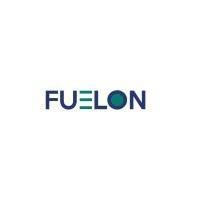





























































































The SolarQuarter Sustainability Leadership Awards 2024 celebrate the outstanding achievements and innovative contributions of organizations and individuals in the realm of sustainable energy This prestigious event recognizes leaders who have demonstrated exceptional commitment to advancing renewable energy solutions, reducing carbon footprints, and promoting environmental stewardship. By honoring those who pioneer groundbreaking technologies and sustainable practices, the awards aim to inspire further progress and collaboration in the quest for a greener, more sustainable future.









SOLARQUARTER
STATE LEADERSHIP AWARDS
The Solarquarter STATE LEADERSHIP AWARDS in TAMIL NADU celebrate excellence and innovation in the solar energy sector. These awards honor individuals and organizations that have made significant contributions to the development and implementation of solar energy projects in the state The winners have demonstrated exceptional leadership, dedication, and a commitment to sustainable energy solutions, setting benchmarks for the industry






























































The SolarQuarter Sustainability Leadership Awards 2024 celebrate the outstanding achievements and innovative contributions of organizations and individuals in the realm of sustainable energy. This prestigious event recognizes leaders who have demonstrated exceptional commitment to advancing renewable energy solutions, reducing carbon footprints, and promoting environmental stewardship By honoring those who pioneer groundbreaking technologies and sustainable practices, the awards aim to inspire further progress and collaboration in the quest for a greener, more sustainable future.






















